#Mazda Familia Sport-4
Explore tagged Tumblr posts
Photo


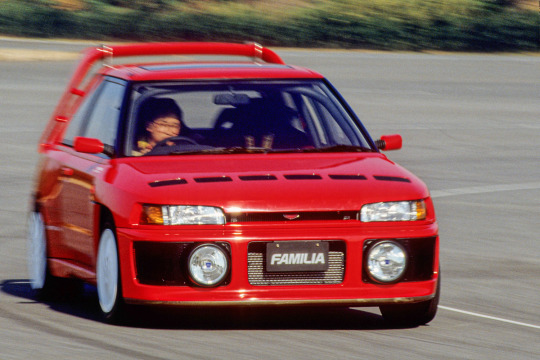
Mazda Familia Sport-4
312 notes
·
View notes
Text
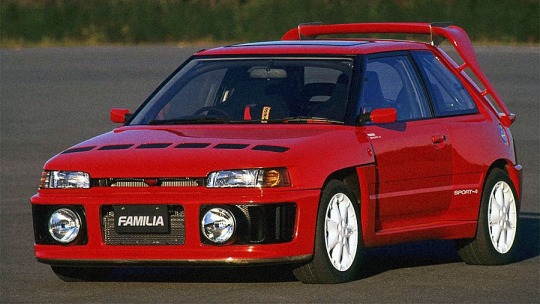
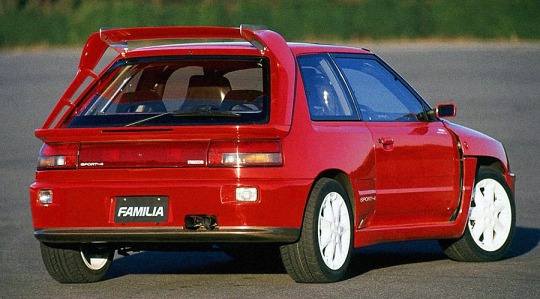
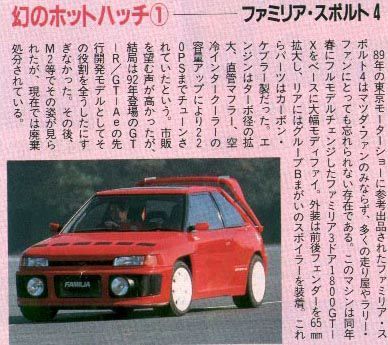
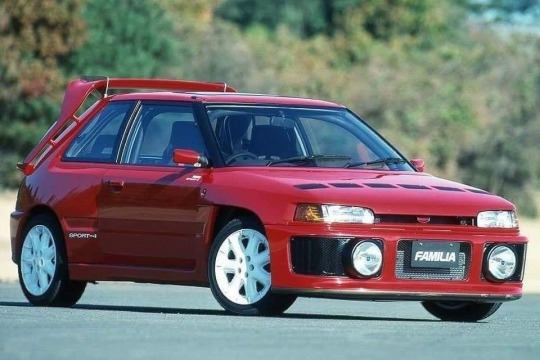
Mazda Familia Sport 4.
Originally i only had the 3rd pic but did some digging and found more pics and info. Translating the 4th pic this was a demo car built for the 1989 Tokyo Motor Show
TRANSLATION OF 4TH PIC
The Familia Sport 4 exhibited as a reference at the 1989 Tokyo Motor Show
Sport 4 is an unforgettable experience not only for Mazda fans but also for many racers and rally fans. This machine is based on the Familia 3-door 1800GT-X, which underwent a full model change in the spring of the same year, and has undergone major modifications. For the exterior, the front and rear fenders are enlarged by 55mm, and the rear is equipped with a spoiler similar to a group B. These parts are made of carbon fiber.
The engine was said to have been tuned up to 22OPS by increasing the turbo diameter, 65mm straight pipe muffler, and larger air-cooled intercooler capacity. Although there were many requests for commercialization, in the end it only fulfilled its role as a pre-development model for the GT-R/GT-Ae that appeared in 1992. After that, it was seen in M2, etc., but it is currently disposed of.
114 notes
·
View notes
Text

2 notes
·
View notes
Photo


M2 Incorporated ‘M2-1023′ Mazda 323/Familia Sport-4
3 notes
·
View notes
Text
1989 Mazda Familia Sport-4 Prototype


101 notes
·
View notes
Photo


Mazda Familia Sport-4, 1989. Two prototypes were built for Mazda’s Group A WRC campaign.
429 notes
·
View notes
Text
The greatest of all time!
And no, you can not prove us wrong, it just is not possible! Group B rally was the greatest racing of all time. The cars was crazy fast, built to the limit (sometimes beyond), the action was never ending, the drivers were like gladiators. The class launched in 1982 with virtually no limits on performance, it was a class for manufactures to show what their engineering teams were capable of. Engines ranged from 1400cc up to almost 5000cc, many cars were turbo or supercharged. The drive train configurations varied greatly as well. AWD, FWD, RWD, front engine, mid engine and rear engine cars were all on the grid. And really becuase everyone spared no budget, they were all very competitive. Of course you know the staples; the Ford RS200, the MG Metro 6R4 and like but there were others that were not as popular or never made it to a race because almost as quick as Group B started it was ended due to a number of horrible accidents. Lets take a look at some of the rarer cars.

The Mitsubishi Starion.

The Giocattolo

The Lancia ECVII

Mazda RX7 EVO

The Mazda Familia Sport 4
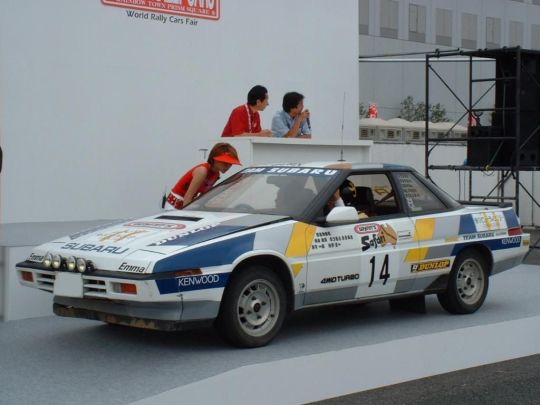
The Subaru XT

The Polonez 2000
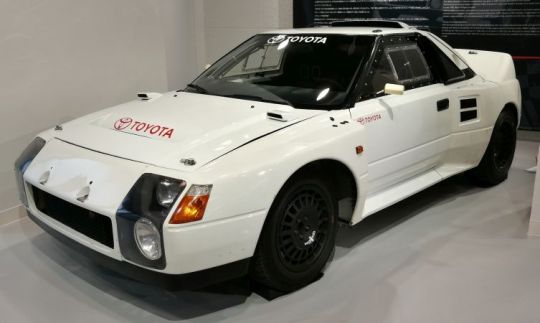
The Toyota 222D

The Talbot Horizon
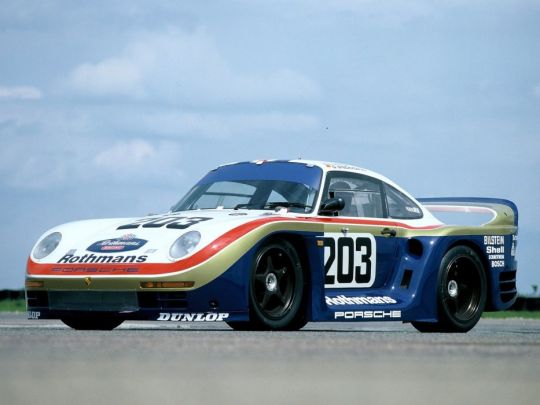
Porsche 959
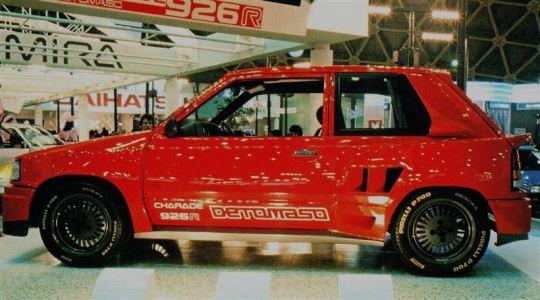
The Diahatsu Charade DeTomaso 926R
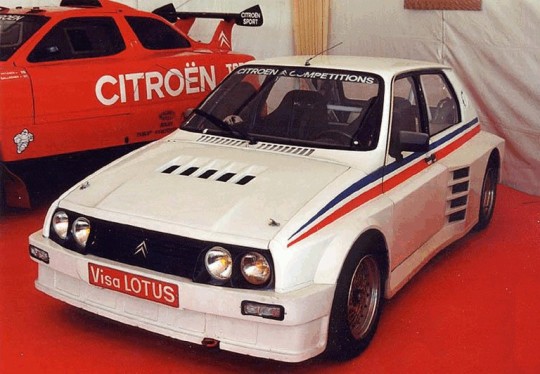
The Citroen Lisa Lotus
10 notes
·
View notes
Text
Mazda Eunos Cosmo: Costs, Facts, And Figures | HotCars
New Post has been published on https://coolcarsnews.com/mazda-eunos-cosmo-costs-facts-and-figures-hotcars/
Mazda Eunos Cosmo: Costs, Facts, And Figures | HotCars

Now a vintage era and genre associated with car, the '90s noticed Japanese sports cars achieve new peaks, introducing nevertheless beloved legends to the roads with awesome styling, plus wicked performance. When considering Mazda's contribution to this, the particular RX-7 is mainly what occurs to you. Legendary for their high-revving rotary power, the unique powerplant acquired its hits, but among the best to use it ended up becoming remembered by very few outdoors Japan — the Eunos Cosmo.
A good evolution of Mazda's most beautiful '60s classics, the Eunos Cosmo was created at the tail finish of Japan's Bubble Economic climate and was packed with not just some of the most advanced tech, high-class, and features of the time, but additionally had an insane rotary motor that hasn’t been observed since. Not an all-out sports vehicle, the Eunos Cosmo was obviously a luxury-focused grand tourer that will lasted from 1990 till 1996 and is much more than the '90s JDM machine.

If the Cosmo in the Eunos Cosmo name sounds familiar, if you're most likely thinking of the particular iconic 1st generation Cosmo , which was one of the first rotary-powered street cars ever made, after the German born NSU Wankel Spider. Not only groundbreaking, the Cosmo is really a classic today for its magnificent looks, and help in showing the rotary’s viability within real-world driving — regardless of its quirks.
Debuting for sale in 1967 ( like Toyota’s similarly iconic 2000GT ), the Cosmo lasted till 1972, evolving in ‘75 to the United states design influenced Cosmo AP, and again in '81 into the boxy Cosmo HB. While cool, and still rotary-powered, the second and third-generation Cosmos weren’t as special since the first, and when the fourth gen, the Eunos Cosmo came out, they’d be nearly mediocre compared to it. Debuting within 1990, the Eunos Cosmo, aka the Cosmo JC, was made with the immediate purpose of being the “ best ever rotary-powered car , ” plus would back that objective up with plenty of substance.
More on the Eunos name though, as it was obviously a Japan-exclusive nameplate that proclaimed Mazda’s high-end, sporty devices, including versions of their current Familia commuter, the MX-5 Miata (sold as the Eunos Roadster), and then to fill up that lineup, the Eunos Cosmo. Being t he or she last car to bear the particular Cosmo name, the Eunos Cosmo would end the queue with a bang, with a very luxurious interior, unique plus powerful engine, as well as unusual tech for the time, let alone a design that’s refined and refined.

Before getting yourself into the luxury and tech benefits though, the Eunos Cosmo's engine is one of the most amazing and attention deserving facets of the car. With the more iconic rotary beasts like the FD era RX-7, the twin-turbo 2-rotor 13B was the biggest you can get stock, though that’s not really a bad thing, as the small 1 . 3 L electric motor could lay out up to 280 hp (according to the Gentleman’s Agreement) at its through the factory. Some other serious rotaries Mazda produced included the race-use only, Le Guys winning 26B 4-rotor , but the Eunos Cosmo has been devised from the start to have the biggest road-going rotary engine available up to that point.
Coming in at a small shift of 2 . 0 T, the twin-turbo 20B 3-rotor that was a product of this objective doesn’t seem all that insane on paper, but when considering the exclusive way rotaries produce strength, this was considered to be equivalent to a V12 . Also crazier than 3 brake discs, the Eunos Cosmo furthermore was the first use of the sequential twin-turbo system on the rotary engine, bestowing that will system to both the 20B, as well as the cheaper 13B 2-rotor option offered in it : which would be used in the RX-7 FD 2 years after the Eunos Cosmo's debut.
While the 13B was nevertheless great, the 20B is among the most epic it offered, furthermore being the most powerful manufacturing plant Japanese engine of the time having a mighty 280 hp -- though was considered to be as powerful as 320 hp due to the Gentleman’s Agreement, which basically was Japan's automakers arriving together to limit stated horsepower from the factory within 1989. Still powerful, the particular 13B made less than the particular RX-7 that would later utilize it, but still provided an sufficient 230 hp. Having an RWD layout and two high-revving, high-power engines, the particular Eunos Cosmo could have been a good unrestrained monster of a sports vehicle, but to achieve their luxurious goals was toned straight down, only including a 4-speed auto for transmission choices. As well, handling also centered on the luxury side with a much softer ride and easy steering, producing cornering ability not all that will great. 0-60 MPH took close to 6. 5 seconds, as well as the weight was a portly yet relatively light for these days 3, 550 lbs.

As stated, the Eunos Cosmo’s objective of being the best rotary car was based more around luxurious and quality rather than raw sports car performance, one glance at the interior makes this focus apparent. Designed using a seriously cool wrap-around dashboard, with a hideaway measure cluster for the driver, the particular Eunos Cosmo’s interior provides aged far better than most other 30-year-old Japanese cars, to the point it could almost pass being a modern design.
Being JDM although, the interior can be a bit little for Americans but still is definitely an awesome one. The thickly cushioned leather seats are fantastically plush and comfortable, natural leather trim throughout the interior accentuates the experience, and a whole sponsor of features makes it the standout cockpit. What actually makes the Cosmo special can be its tech features, that was the first production vehicle to have a built-in GPS navigation program, amazingly advanced for 1990. Using a CRT touch screen as an infotainment system too, the Cosmo was in front of its time, having from the GPS navigation, to the weather control, to the stereo, in order to even a TV system getting controlled by that touch screen.
Complimenting this, many features and options you’d anticipate in a 1990's luxury vehicle were available on the Eunos Cosmo, from power-adjust chairs as standard, an auto-retracting steering wheel to get in and out, car up/down windows, a car telephone, and 12 disk compact disc changer among other advantage. All the tech, leather, plus general luxury would be moot if the Cosmo rode just like a sports car though, and as talked about, it was a sumptuous easy riding bike instead. Suspension is smooth, and one unique aspect of it had been that the rear used four shocks rather than 2 . Consuming this further, the 20B motor is unbelievably smooth, revving like butter to a 7k redline — a number restricted to the transmission, as a 20B can rev to over 8k.

With Eunos Positioned being a Lexus/Infiniti style luxury sub-brand, the particular Cosmo was a luxurious plus much more expensive car compared to the parent brand. But , in contrast to what Lexus and Infiniti typically did, a completely distinctive platform and engine had been developed for the Cosmo, not really sharing it with any kind of normal models. Thanks to this particular and the plentiful advanced technology, prices were seriously higher for the time, even in Japan’s bubble economy. Sold having a base associated with $27, 200 in 1990 , the most basic Eunos Cosmo was the equivalent of $55, 123 in today’s money and may balloon to $43, 650 when optioned fully (around $88, 461 today) which makes it a slightly cheaper rival to luxury grand tourers like BMW’s 8-series, yet without an established luxury nameplate attached to it - even though its true virtues had been more than competitive in that industry. Never sold outside The japanese, just almost eight, 875 Eunos Cosmos had been sold more than its model run, which makes it as rare as it is high-class.
Expensive plus rare as it was whenever new, the Eunos Cosmo is now a serious deal to get an unique JDM classic, because 25 years have passed considering that its production ended and they also can now be brought in to the USA . With all the 13B engine, an Eunos Cosmo today can be had for approximately $15, 000 already brought in, and the epic 3-rotor 20B version costs around 20 dollars, 000 to $30, 1000. Compare that to an FD generation RX-7 from the period, which now costs $30, 000 on the lowest finish, and the Eunos Cosmo is a wonderful value if you love rotaries yet prefer a more subtle plus luxurious experience.
Sources: Motortrend, Mazda, The Truth About Cars
NEXT: Ahead Of Its Period... The 1970 Mazda RX-500 High-Speed Rotary Concept
1 note
·
View note
Text
Mazda
В субботу я забрал свой новый автомобиль. Выбор мой пал на Mazda 6 не случайно. Помимо субъективных ощущений от вождения этой машины, меня так же подкупила история компании. Поехали знакомиться.

Компания, история которой началась ни много ни мало – с пробки. Именно строительными материалами из пробкового дерева и занималась компания, основанная Джуджиро Мацуда (Jujiro Matsuda) в 1920 году.
Мацуда, родившийся в 1875 году двенадцатым сыном рыбака в префектуре Хиросима, в 20 лет открыл собственную кузню, но вскоре она закрылась из-за убытков. Через 11 лет он снова открыл кузню и даже получил патент на насос для закачки воздуха, но уже через несколько лет компания снова закрылась. После еще нескольких попыток открыть свое дело Мацуда в 1920 году вместе с группой инвесторов скупил разорившуюся компанию Abemaki, находившуюся в Хиросиме и занимавшуюся пробковым деревом. Ее переименовали в Toyo Cork Kogyo и в следующем году Мацуда стал ее президентом. Компания на тот момент никакого отношения к автомобилям не имела и выпускала вышеупомянутые стройматериалы из пробки. Это занятие позволило заложить финансовый фундамент для дальнейшей деятельности. В 1927 году из названия компании выпало слово “cork” – пробка, и компания стала носить имя Toyo Kogyo., Ltd., что было следствием перехода к промышленному производству. Выпустив в 1920-х годах небольшую тестовую партию мотоциклов, в 1929 году компания перешла к производству станков. В 1930 году один из выпущенных компанией мотоциклов даже выиграл гонку.
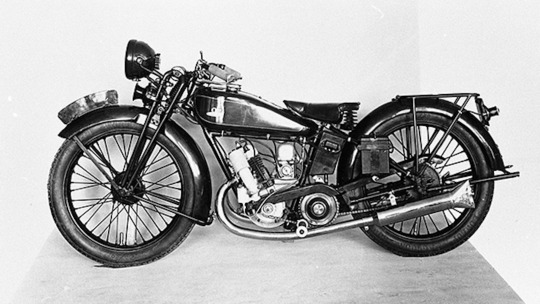
Трехколесный грузовичок.
В 1931 году компания начала выпускать автомобили в чисто японском стиле – трехколесные грузовички c двигателями объемом 500 куб.см. В качестве торговой марки для обозначения этих машин было выбрано слово Mazda – имя зороастрийского верховного бога света, которое к тому же было очень близко по звучанию к имени основателя компании – Мацуда. А в 1932 году начался экспорт грузовиков Mazda в Китай. До того, как началась Вторая мировая война, компания создала несколько концептов легковых автомобилей, но в серийное производство ни один из них пойти не успел.

Mazda R360.
После войны и атомного взрыва в Хиросиме завод Toyo Kogyo, к счастью, был разрушен лишь меньше чем наполовину, и уже в 1950 году компания начала выпускать трехколесные грузовики с двигателем 1157 куб.см Type CT, компактные пожарные машины и обычные грузовики. В 1952 году умер Джуджиро Мацуда; за год до этого президентом компании стал его сын Тенуджи. Компания начала выпускать легковые автомобили только в 1960 году, когда уже начался рост благосостояния рядовых японцев. Первой моделью стала R360 – 2-дверная городская машина, оснащенная 2-цилиндровым двигателем объемом 356 куб.см. Она не отличалась особыми изысками, зато была недорогой и удобной.
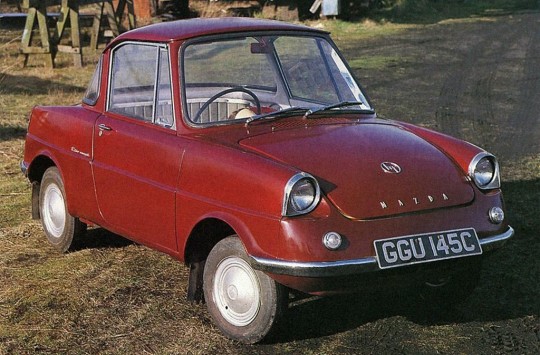
Wankel-Yamamoto. Ро��орный двигатель.
Кроме этого, в 1960 году случился ряд событий, сыгравших в дальнейшей истории Mazda большую роль. Компанию посетил представитель немецкой компании NSU доктор Хаас, а президент Мацуда нанес в Германию ответный визит, и было заключено предварительное соглашение о сотрудничестве с NSU в области разработки и производства роторных двигателей Ванкеля. Официальным началом этого сотрудничества считается 1961 год, когда соглашение получило одобрение японского правительства. В том же году вышел компактный пикап Mazda Proceed (B-series 1500).
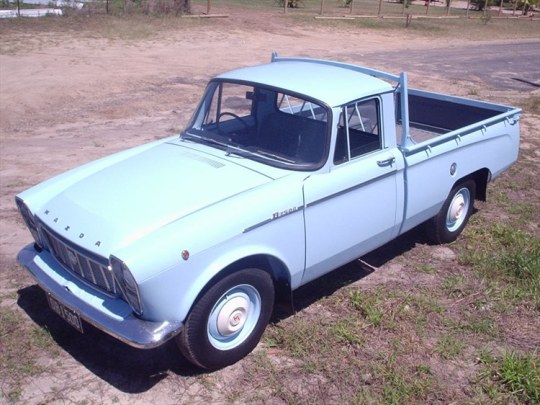
Через год модельный ряд увеличился – появилась Carol, модель в двух вариантах: 2-дверная Carol-360 и 4-дверный седан Carol-600. Своим дизайном Carol, как и многие ранние японские автомобили, повторяла модель Ford Anglia.

Уже в 1963 году общее количество выпущенных автомобилей достигло 1 миллиона, и в Токио был показан первый произведенный компанией роторный двигатель. В 1964 году началась история модели Familia – было представлено ее первое поколение. Модель Mazda 800cc Station Wagon начинает импортироваться в Новую Зеландию.
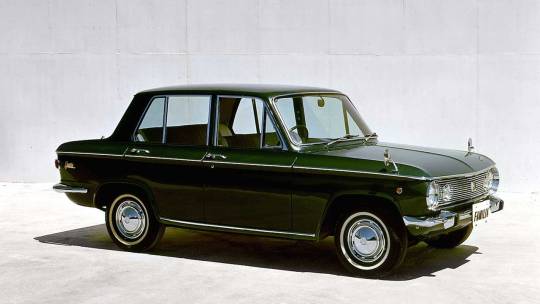
Построив в 1965 году испытательный полигон Миоши, Mazda начала техническое сотрудничество с английской компанией Perkins Services N.V. в области дизельных двигателей. 1967 стал годом дебюта модели Cosmo Sports (110S) – первой модели Mazda с роторным двигателем. В том же году начался полномасштабный экспорт на европейский рынок.
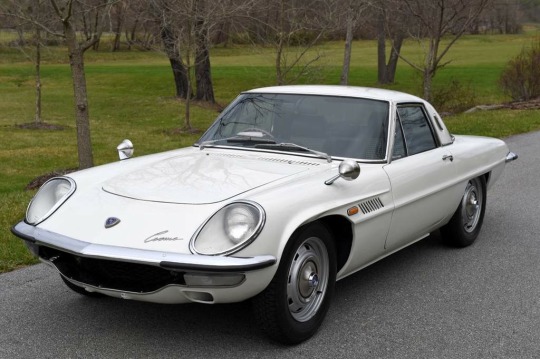
В следующие годы началось производство одной модели с роторны�� двигателем за другой: 1968 год – Familia Rotary Coupe (R100), 1969 – R100 Rotary SS Sedan, 1970 – Capella RX-2. К 1970 году было произведено 100 000 автомобилей с роторным двигателем. Кроме этого, в 1969 году Mazda впервые вступила в сотрудничество с Ford – в области совместного производства автоматических трансмиссий, открыла сборочный завод в Новой Зеландии, а в 1970 году начался экспорт автомобилей в США.
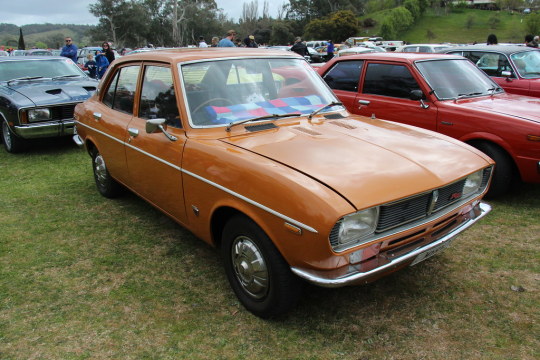
Mazda Savanna RX-7
1970-е годы открылись еще одной моделью с ротором – Savanna (RX-3), выпущенной в 1971 году.
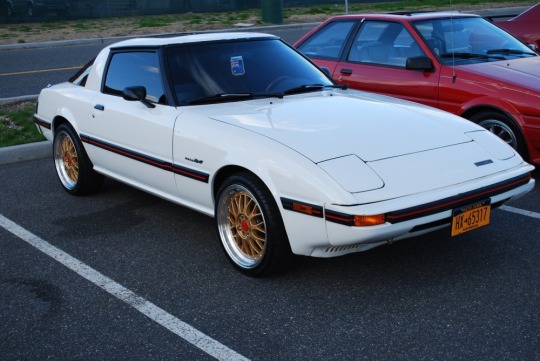
В следующем, 1972 году, вышла Luce (RX-4). Компания преодолела рубеж в 5 миллионов произведенных автомобилей, а в 1973 экспорт достиг 1 миллиона автомобилей. Автомобили с роторным двигателем продавались достаточно успешно, но разразившийся в 1974 году нефтяной кризис нанес им порядочный ущерб – роторы потребляли больше топлива и масла, чем другие двигатели. Но в 1978 году, был выпущен миллионный автомобиль с роторно-поршневым двигателем. В 1979 году Род Миллен уехал в США и стал там чемпионом по ралли, выиграв гонки на автомобиле Mazda RX-7 два года подряд. В то же время Ford Motor приобрел 25% акций Toyo Kogyo.
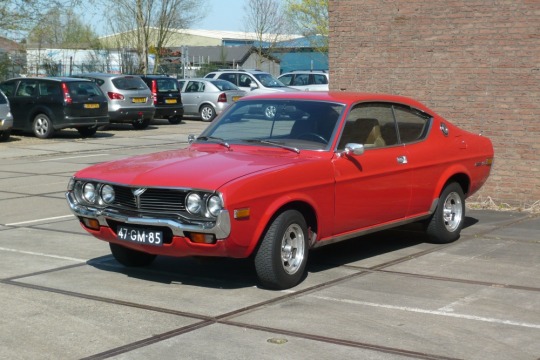
В 1980 году Mazda Familia стала автомобилем года в Японии. Автомобильная марка Mazda в это время уже заняла твердые позиции на мировом рынке. В США и Европе в 1981 году открылись ее представительства, а в 1982 году автомобилем года в Японии стала Capella. Она же в 1983 году была признана лучшим импортным автомобилем в журнале Motor Trend и получила множество престижных зарубежных наград. На испытательном полигоне Миоши была построена лаборатория аэродинамических испытаний; появилось новое семейство микроавтобусов – Bongo/Bongo Brawny. Mazda вступает в финансовый союз с Kia Motors, купив 8% ее активов. А в 1984 году компанию переименовали в Mazda Motor Corporation. В 1986 году журнал Motor Trend назвал Savanna RX-7 импортным автомобилем года; тогда же эта модель установила национальный рекорд скорости в Бонневиле – 383.724 км/ч в классе SCTA’s C/Grand Touring. В 1987 году, в честь 20-летия роторного двигателя Mazda, вышла Savanna RX-7 в кузове кабриолет. В Мичигане начинается производство автомобилей на новом заводе – Mazda Motor Manufacturing Corporation (MMUC); открывается новый исследовательский центр в Йокогаме; выходит произведенная на заводе Mazda модель Ford Festiva (121). В 1988 году в США открываются Mazda Motor of America Inc. и Mazda Research and Development of North America, Inc. (MRA) – для объединения всех связанных с Америкой операций. На американском рынке появляется модель MPV. Mazda разрабатывает новую технологию окрашивания – покрытие Hi-Reflex. На автосалоне 1989 года в Чикаго Mazda представила родстер MX-5 Miata. Благодаря удачному дизайну и невысокой цене эта модель завоевала огромную популярность в США и других странах.
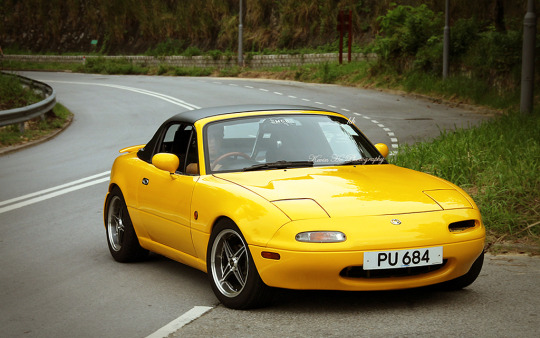
На автосалоне же в Токио была пр��дставлена другая модель – Autozam Carol. Mazda начала импортировать в Японию Citroen BX, а в следующем, 1990 году - Citroen AX.
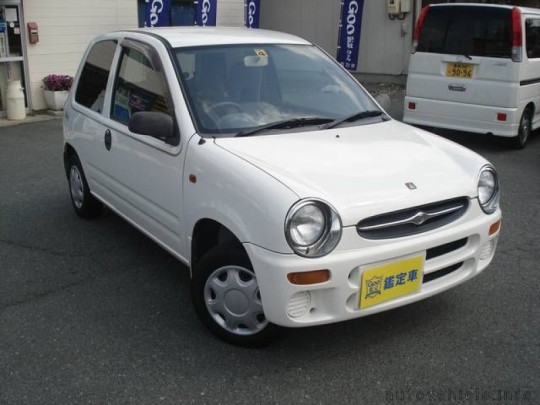
В 1990 году в Японии появились такие модели, как MPV
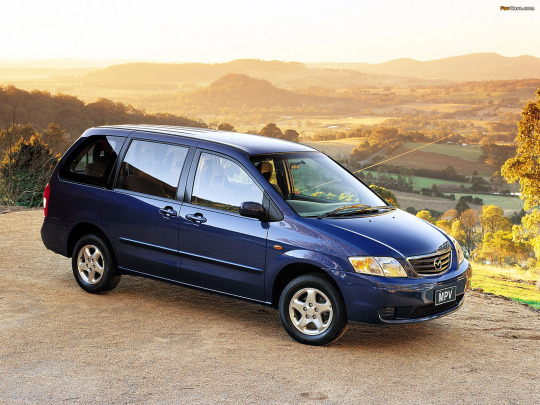
Eunos Cosmo (оснащенная автомобильной навигационной системой)
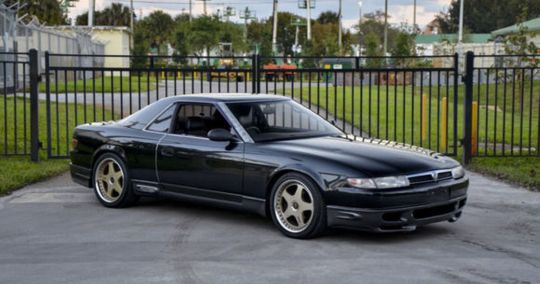
Autozam Revue (121).
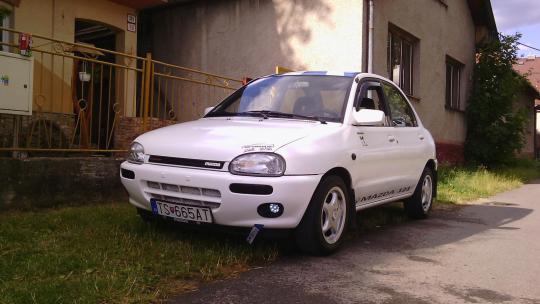
MX5 стала автомобилем года в Новой Зеландии, общее количество произведенных автомобилей достигло 25 миллионов (из них 1 миллион экземпляров модели RX-7), открылось представительство в Германии. 1991 год – в Японии выходит седан класса "люкс" Sentia (929)
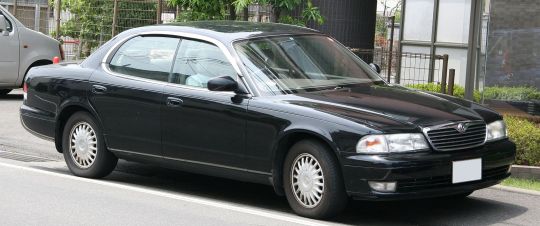
Автомобиль Mazda 787B выигрывает 24-часовую гонку Le Mans (это была первая победа в этой гонке, одержанная автомобилем японского производства и единственная победа автомобиля с роторным двигателем)
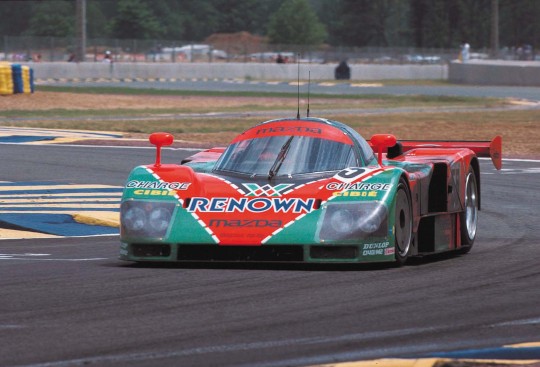
На 29-ом автосалоне в Токио представлен концепт HR-X с роторным двигателем, работающим на водороде
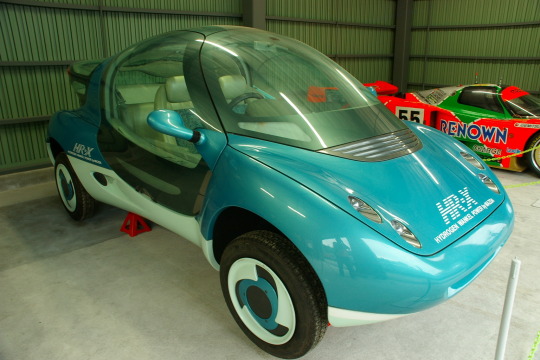
1992 год – продается 300-тысячный автомобиль MX-5 в мире;
RX-7 выигрывает 24-часовую гонку в Дайтоне в классе GTU 11 год подряд;
Mazda Motor Manufacturing Corporation в Мичигане, США, становится компанией AutoAlliance International, Inc. (AAI) с равными долями в ней Mazda и Ford;
Через канал продаж в Японии Eunos представлена новая модель – MX-6, а также эксклюзивно для внутреннего японского рынка через канал продаж Autozam начинает выпускаться модель AZ-1, двухместный микромобиль, и модель Eunos 500 (Xedos 6). В то же время бурно развивается экологическое направление деятельности компании: принимается "Глобальная экологическая хартия Mazda", разрабатывается новый нейтрализующий катализатор, который восстанавливает масло из всех типов пластика, а также первый в мире пластиковый композит многократной переработки. В Германии и Японии открываются экспериментальные заводы по сборке и вторичному использованию пластмассовых бамперов. В 1993 году Mazda выходит на филиппинский рынок легковых автомобилей. С Ford заключается долгосрочное соглашение с целью улучшения конкурентоспособности автомобилей. На автосалоне во Франкфурте выставляются HR-X2 и прототип модели Eunos 800 (Xedos 9), вызвавший большой интерес. А в Японии появилась новая спортивная компактная модель – Mazda Lantis.
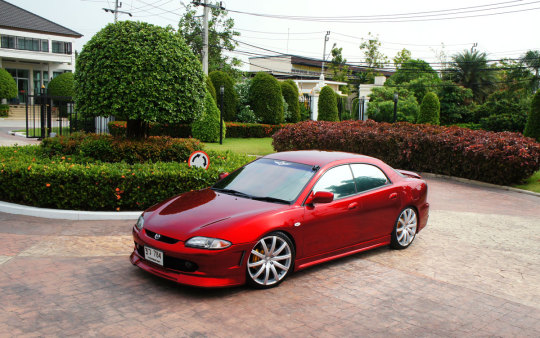
Через год, в 1994 году, открывается музей Mazda, разрабатывается грузовик, работающий на сжатом газе, а также электромобиль на базе фургона E-класса. Во Флориде и в Китае открываются тренировочные центры Mazda, появляется новая модель – минивэн AZ Wagon, и Mazda первой среди японских автопроизводителей получает экологический сертификат ISO 9002.
В 1995 году общее количество выпущенных автомобилей модели Familia (323) в Японии достигает 10 миллионов при общем количестве выпущенных автомобилей Mazda в 30 миллионов. Открывается представительство в Португалии. Mazda начинает тестирование водородных автомобилей на дорогах общего пользования; начинает продаваться новая модель – Bongo Friendee.

В следующем, 1996 году, процент доли Ford увеличился с 25% до 33,4%, президентом компании стал Генри Уоллис, в Японии начала продаваться новая модель – Demio, и в том же году начались ее продажи за рубежом, и она к тому же стала автомобилем года в Японии.
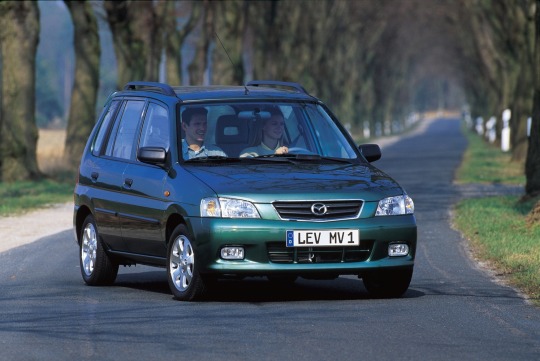
На европейском рынке начала продаваться модель 121, произведенная на заводах Ford. Mazda запустила систему “Mazda Digital Innovation (MDI)” – информационную технологию, позволяю��ую радикально обновить все стадии производства автомобилей – от планирования до сборки. Mazda получила сертификат ISO 9001, снова первой среди японских автопроизводителей. В 1997 году изменился логотип компании на нынешний; в компании вводится новая система поощрения персонала; возобновляется экспорт продукции на Тайвань; президентом компании становится Джеймс Миллер; разрабатывается модель Demio FCEV, работающая на топливных ячейках.
В следующем, 1998 году Mazda вступила в альянс Ford/Daimler-Benz/Ballard с целью разработки технологии топливных ячеек, открывает консультативный центр по трудоустройству женщин, усиливает свое присутствие на европейском рынке, начинает производство маленьких турбодизельных двигателей с непосредственным впрыском.
В 1999 году модель MX-5 отметила свое 10-летие, было достигнуто соглашение с Mitsubishi – Mazda начала поставлять Mitsubishi небольшие коммерческие автомобили. В производство была запущены новые модели – Tribute и Premacy. Помимо этого, был сделан такой шаг, как улучшение условий работы для женщин. Президент компании снова поменялся – им стал Марк Филдс.
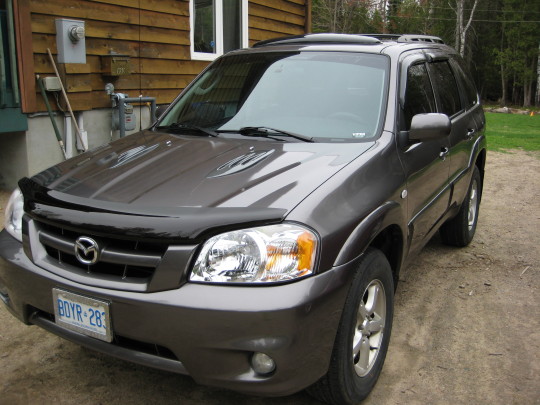
2000 год ознаменовался выходом Mazda в сферу электронной коммерции – был основан “e-Business Enabling Office” и предприняты шаги по улучшению взаимодействия с клиентами через Интернет. Mazda Roadster, которая в этом году получила совершенно новый дизайн кузова, попала в книгу рекордов Гиннесса. На автосалоне в Детройте был показан концепт RX-Evolve, предшественник ныне выпускаемой модели RX-8.
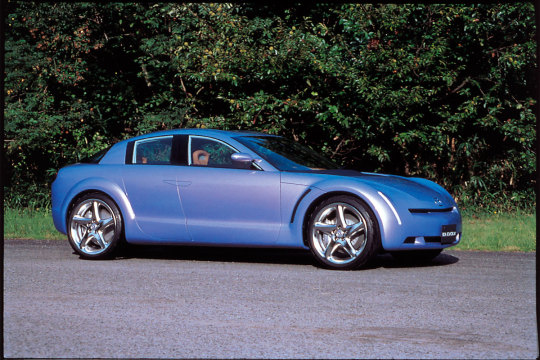
Mazda приняла участие в совместном с Daimler Chrysler Japan Holding и Nippon Mitsubishi Oil проекте испытания автомобилей на топливных ячейках.
2001 год – на автосалоне в Токио демонстрируется новая Atenza и предварительная версия RX-8 с роторным двигателем Renesis; завод Ford в Валенсии, Испания, выбирается как европейская база для производства компактных автомобилей Mazda; Roadster получает главный приз "Auto Color Award 2001"; Mazda расширяет сферы применения материалов из переработанных пластиковых бамперов. Многие модели Mazda в этом году получили дополнительные, "спортивные" модификации. В 2002 году компания открыла собственные ясли и выпустила новую модификацию модели MPV – Sports F, разработанную женщинами, приняла участие в праздновании 100-летнего юбилея изобретателя роторного двигателя – Ванкеля, вышла на автомобильный рынок Китая с моделью 323, разработала первую в мире технологию экологически благоприятного покрытия, развивала программу по подбору персонала.
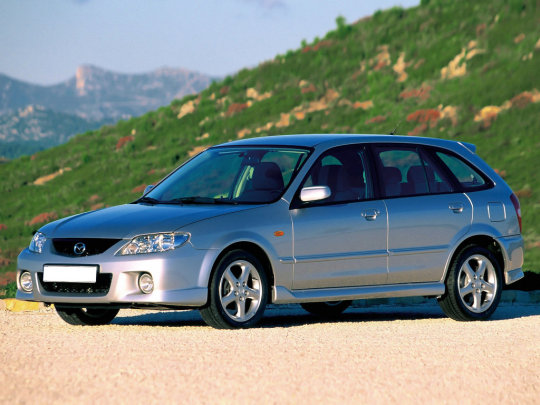
В настоящее время Mazda отказалась от выпуска люксовых автомобилей (которые в ее модельном ряду были представлены седаном Millenia).
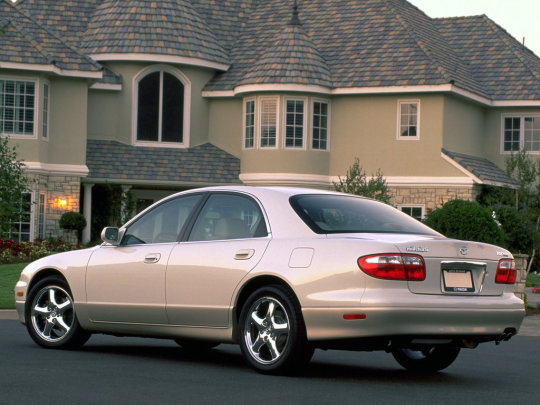
Основной упор в производстве делается на легковые автомобили малого и среднего класса, а также спортивные модели, что руководство Mazda считает более перспективным и эффективным для дальнейшего развития компании. В гамме спортивных моделей на смену всемирно известной модели RX-7 пришла RX-8. В вопросах стратегии развития и продаж компания тесно взаимодействует с Ford, хотя в производственную сферу Ford не вмешивается. Mazda по праву может считаться мировым автопроизводителем – ее сборочные заводы в 21 стране позволяют ей экспортировать свои автомобили в 120 государств мира.
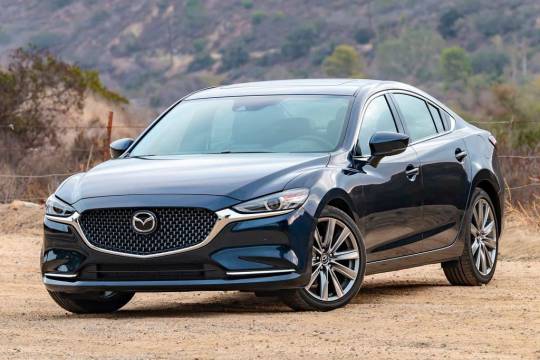
0 notes
Photo

1989 Mazda Familia Sport 4 Prototype 撸先生:看片神器,每日更新,高清流畅,无需翻墙,t.cn/EVvnoK4
1 note
·
View note
Photo
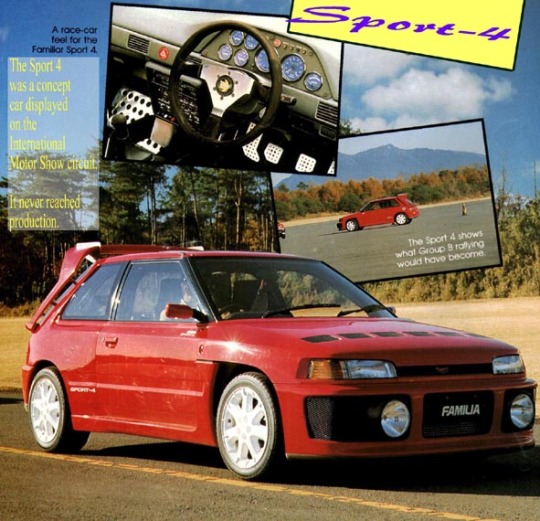
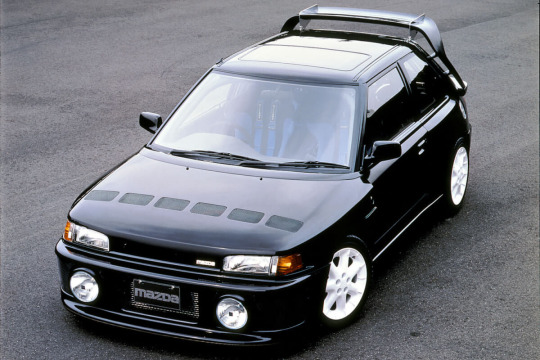
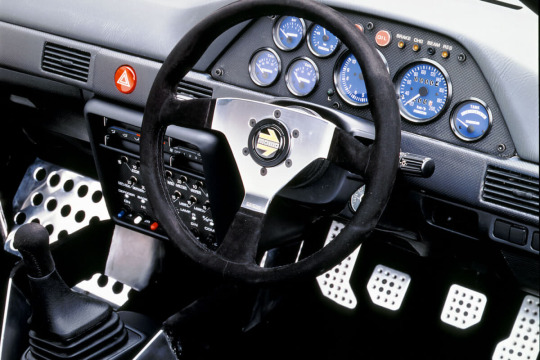
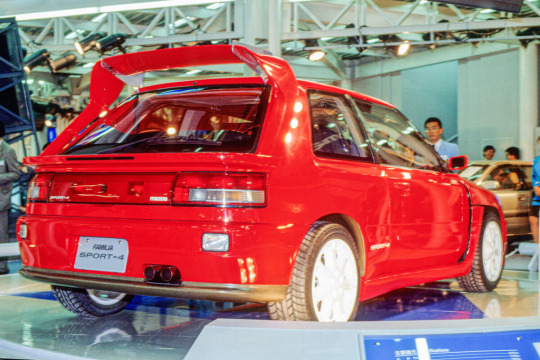
Mazda Familia Sport-4
13 notes
·
View notes
Text
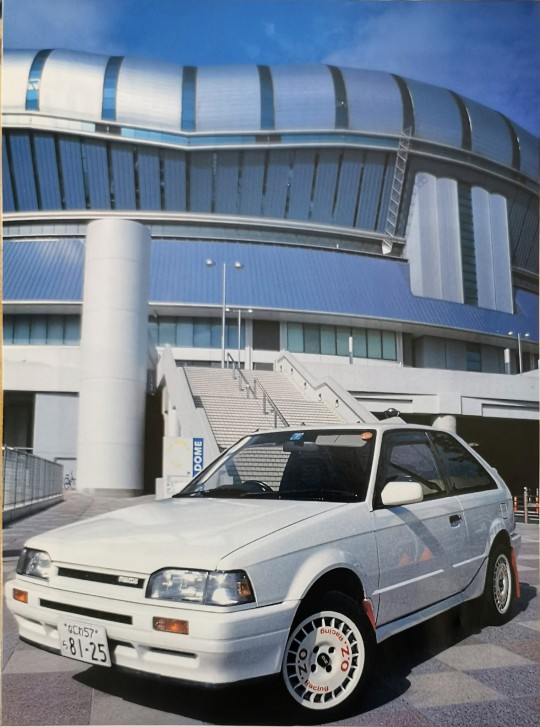
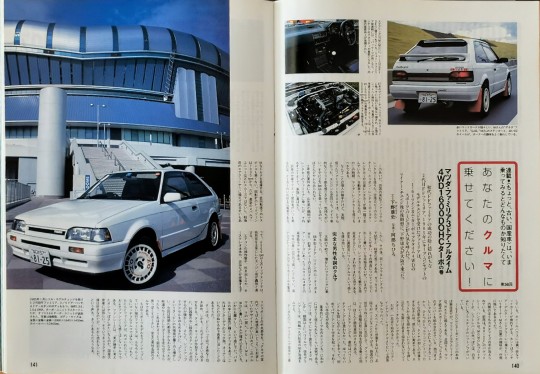
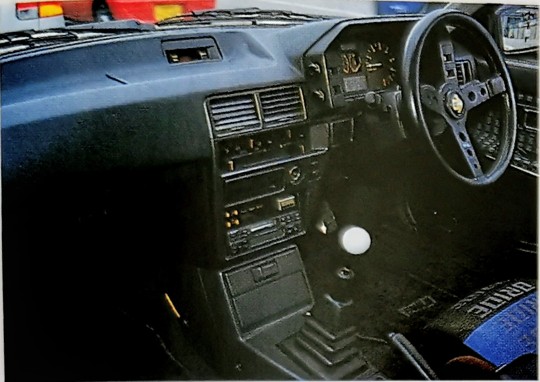

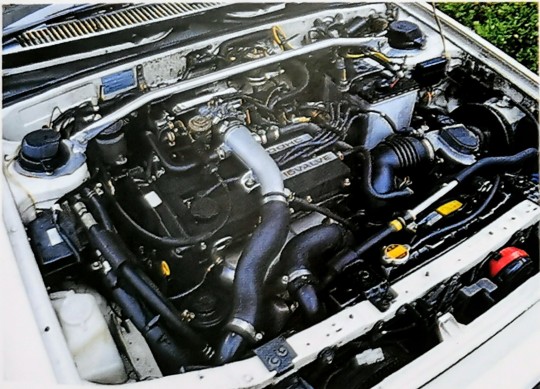
What are old cars like to drive now?
Mazda Familia 3 door full time 4WD1600DOHC turbo review.
The second generation FF Familia tends to be overshadowed by the success of the first FF Familia. The Familia underwent a Key Concept model change in 1985, and the sports version of the 1.6 (twin cam turbo + full-time 4WD) became popular. Yasushi Shimono drove to Osaka for the later model after minor changes.
Text | Yasushi Shimono Photos Chihiro Abe
The other day, I rented a Familia car in Takamatsu, Shikoku. If you see Nippon Rent-a-Car, Toyota Rent-a-Car, and Nissan Rent-A-Car lined up at the counter in the airport lobby, if you're a car fan, you should probably rent a Mazda Rent-A-Car at this time of year.
It's a personal choice, but the Familia 1500AT I rented was actually very nice. The engine and suspension have the solid feel of a German car, and it feels great. Even though I've already driven over 20,000km, I can barely see any wear and tear.
During my summer vacation two years ago, I took a Familia rental car at the station in Tsuruoka, Yamagata Prefecture, and it was a great ride, and my family was happy with it.
For test drives, members of the media always ride in the manufacturer's so-called PR vehicles.
However, when they later try the same car in a rental car, they are often disappointed to varying degrees. I don't have the space to write about the reasons in detail here, but Familia is an extremely rare example of people rediscovering their charm through rental cars. It feels like a very seriously made car.
I am holding this.
FULLY MASCULINE NOUN CAR
In downtown Osaka, I was given a ride on a nostalgic Familia. 1988 model 3 door twin cam turbo 4W.D. It is a full-time 4WD high-performance model that was part of the second-generation FF Familia series that debuted in 1985.
I splurged on expensive 200,000 yen 0Z racing aluminum wheels for the car I bought this spring. There is a bright red mudflap in the wheel arches.
The guard hangs down. The hobby of the owner, Mr. M (35 years old), who really wants to drive a Lancia Delta Integrale, seems to be depicted on the outside.
The inside can also be customized.
It is. The front seats are BRIDE bucket seats. The handle is MOMO's Prototipo. At the tip of the shift lever is a plastic shift knob that looks like a white ball.
The main body of the 1.6LDOHC turbo engine has not been modified, but the muffler and air cleaner have been replaced with "HKS''. The suspension also uses Mazda genuine sports springs combined with GAB dampers. I'm not Kiyoshi Nishikawa, but I get the strong impression that he was trying to do things one by one, starting with what he could do. Mr. M, who works as a tire wholesaler, is a pleasant young man. It is the year of the year. When I pushed in the tape whose head was peeking out from the set, it played Mr. Children, which doesn't really suit Osaka (?).
However, once it started running, the Familia Integrale was a much more radical car than the standard.
First of all, the suspension is much harder than you might imagine from the specs. The ride quality is almost that of a competition vehicle, reacting honestly to the bumps and undulations of the road surface and transmitting short, jerky vibrations.
I didn't think it was power steering at first either. I slowly turned the steering wheel to turn off the engine and realized for the first time that it had power assist. That's how responsive it is. Basically, the normal engine is so energetic that it's hard to believe. Power is already 140 yen on NET display. However, it is more powerful than the face value, and at the signal Grand Prix the acceleration of all four wheels is like that of a rabbit.
I'll show you.
Even though it is a turbo, it starts to crash immediately after idling.
Delivers comfortable torque. The response in the low rotation range is also not bad. Tachometer red zone from 7000rpm. However, the latest 4-valve It's not as smooth and light as the unit.
It has been replaced with an air cleaner for competition. So, at the top end of 6500 or higher, the engine noise, mainly the intake noise, becomes louder.
Air conditioner control panels, air vents, and
-Dark areas where stereo units, ashtrays, etc. are crowded.
There was a designer who once described the center part of the dash as ``the most expensive part of the car's interior,'' but this car has a panel that says ``FULLTIME 4WD'' embedded in part of it. There is. It was kind of noisy. There is also a shiny silver switch inside the spring, and this is for locking the center differential. The owner once benefited from being muddy.
Apparently there is.
The turbo is effective without any noticeable bumps.
It starts to work, and what's more, it works like a turbo. I miss the way the green snail lights up in the instrument panel every time the turbo kick explodes. What's more, every time I shift up and release the accelerator, I hear the resonant whine of the turbine, which is nostalgic. I wasn't able to do it this time due to time constraints, but I was able to drive on mountain passes and some dirt roads, and it still looked really interesting. Manly and sweaty, a perfect masculine noun.
It's Luma.
Of course, the current Familia, which no longer has a sports model in its lineup, is not such a macho car. However, the Familia has always been a car that has not had a fancy feel to it for generations. Fancy is something like ``a womanly thing that a man has come up with.'' I like the character, which is unusual for domestically produced vehicles, but I'm sure there are people who say that's why it doesn't sell well.
PIC CAPTIONS
The second generation FF Familia underwent a full model change in January 1985. It has a 3/5-door hatch and a 4-door sedan body. Initially, it started with 1.3ℓ and 1.5ℓ NA and turbo units, but a 1.6ℓ turbo unit was soon added. The photo is of the later model. The body size is: total length x width x height = 3990 x 1645 x 1405mm. Wheelbase 2400mm.
The steering wheel has been replaced with "MOMO" and the seat has been replaced with "BRIDE". When the New Familia was announced, the company emphasized the improved quality of the interior, saying, ``If the packaging is the same, the quality of the interior is important.''
With minor changes in 8 years, NA unit
The remaining old E-type units were wiped out and replaced by B-type units. Photo of 1597cc 16V DOHC turbo with 140ps @ 6000rpm and 19.0kgm torque @ 5000rpm
Mr. M's Delta Familia has a majestic red mudguard. The ``GAB'' and ``HKS'' stickers and white OZ wheels clearly reflect the owner's taste.
42 notes
·
View notes
Text
New 2016 Mazda CX-3 Shippensburg
Mazda Motor Corporation is a Japanese automobile producer that works in various auto publicizes far and wide. Mazda is arranged in the Fuchu Aki locale in Hiroshima, Japan. The New 2016 Mazda3 York lion's share of their vehicles are conveyed and gathered in their Japan based plants. They are then flowed worldwide to spots where Mazda works. Close to the vehicles conveyed in Japan, Mazda moreover works a couple get together plants all through the globe. Every unit conveyed in these workplaces is passed on direct to their different markets accessible to be obtained.
Mazda in the midst of its most reliable foundation and the Second World War
Mazda's soonest roots are taken after back to the year 1920, when its coordinator Jujiro Matsuda and a bit of social affair of budgetary pros acquired a little association called, Toyo Cork Kogyo. Toyo Cork Kogyo made machine instruments for neighborhood bargains. In 1927, the association changed its name into Toyo Kogyo Co. Ltd. Bit by bit, however no ifs ands or buts, Toyo Kogyo's operation well ordered moved from conveying machine mechanical assemblies to the era of vehicles.
The move in progress came to fruition to the introduction of a three-wheeled truck, called the Mazda-Go in 1931. Adjacent to conveying this vehicle, Toyo Kogyo was also required in the gathering of military weapons used by the Japanese military. These weapons were used as a part of the Second World War, particularly the Type 99 rifle game plan 30 to 35.
Mazda after the Second World War
After the Second World War, Mazda continued making vehicles under the name Toyo Kogyo. Regardless, this was consequently changed to "Mazda" in 1984. According to the association's site, this name was gotten from "Ahura Mazda", a Persian-Zoroastrianism God. Regardless, most auto collectors moreover assume that the association's name was gotten from its coordinator "Jujiro Matsuda." These cases still remain unverified, even up till today. Another question that goes unanswered, is the reason most of the association's most timely vehicles passed on the name "Mazda", regardless of the way that the change of name was not yet executed in the midst of those conditions.

Mazda's reputation started to create in 1960 when the association exhibited its first veritable auto, which was the Mazda R360. The Mazda R360 was a 4-arrange, 2-gateway roadster, controlled by a back mounted air-cooled 356 cc V-twin engine. This engine was mated to either a 4-speed manual transmission or a 2-speed customized transmission. That engine was fit for making a biggest power yield of up to 16 torque and 16 lb.- ft. of torque. The engine was prepared for conveying a top speed of around 52mph.
Adjacent to making vehicles, Mazda's operation moreover incorporated the change of the Wankel turning engine. The association's focus on working up this engine was basically enacted by Mazda's yearning to use this advancement as a strategy for isolating itself from other Japanese auto makers. Mazda's attempts and resources used as a piece of working up the spinning engine at last expanded positive results. The association started offering the as of late made engine in 1962. Following five years, Mazda released the confined discharge Cosmo Sport. This 1967 amusement was energized by Mazda's pivoting engine. This kind of engine was also used as a part of the current RX-8 engine. These events titled Mazda as the sole New 2016 Mazda CX-5 Mechanicsburg automobile producer possessed with the era of the Wankel engines.
Mazda's headway and usage of the turning engine in the R100 and the RX Series extended the association's passages a phenomenal plan. The development in charges was over the long haul taken after by Mazda's augmentation in various areas of the world. In 1968 Mazda started its formal operations in Canada. Two years after, Mazda began its operations in the American market and ended up being to a great degree productive. In like manner of its achievement in America, Mazda made the Mazda Rotary Pickup, which was offered for North American buyers so to speak.
The accomplishment of Mazda in the American and world markets, acknowledged by the creating demands for the pivoting engine, persevered through a vital incident in 1973 when the "oil crisis" happened. Fortunately, the association did not totally surrender the making of vehicles furnished with barrel energized engines. These vehicles saved Mazda complete fall. In this way, the 4-barrel controlled models, for instance, the Mazda Familia and the Mazda Capella course of action, ended up being basic in the midst of those conditions.
Regardless of the abatement well known for vehicles with rotating engines, Mazda could make sense of how to use them in some of their models. Instead of presenting the turning engine, Mazda has used them in recreations cars. The Mazda RX-7 transformed into the essential recipient of this framework in 1978, and was trailed by the present day variation RX-8. The association had similarly focused its thought in developing pretty much nothing and lightweight diversions automobiles with compelling chamber controlled engine. Mazda's attempts to develop this sort of recreations auto achieved the making of the Mazda Roadster or commonly known as the Miata, in 1989. The Mazda Roadster was then given affirmation for reviving the nearness of little amusements automobiles, which started to diminish in the later parts of the `70s.
Mazda-Ford Partnership
Mazda Motor Corporation developed an association with Ford Motor Company when Mazda experienced budgetary turmoil in the 1960s. Entry transformed into a prepared theorist and the American auto maker earned a 7% fiscal stake in 1979, which had then extended to 27% in the midst of the `80s. Since Mazda had been encountering financial difficulties, Ford continued getting a segment of the association's stakes, and in 1996 Ford could build 33.4% of Mazda's cash related stakes. These stakes, in any case, were sold by Ford in 2008, when the American car creator was struck by the negative effects of the world cash related crisis. Therefore, Ford diminished its commitment with Mazda's operation, which at last allowed the Japanese auto maker to manage its own issues and attract the overall auto exhibit with the most outrageous flexibility.
Close to picking up Mazda's budgetary stakes, Ford was similarly required in a couple wanders with its as of late settled associate. By far most of these endeavors were based on the progression of more diminutive automobiles and pickups. Next to this, Mazda had also granted some of its resources for Ford. The Mazda Familia granted its phase to a couple Ford models, for instance, the Escort and the Laser. Mazda Capella's outline was in like manner used as a piece of Ford's Probe sports exhibit and the Telstar.
Besides, Mazda had also forded develop some of its own vehicles, fusing the Ford Explorer in 1991. Honestly, Mazda moreover sold a practically identical vehicle called the Mazda Navajo, yet its arrangements transformed into a mistake. In this way, the Japanese auto maker stopped offers of the Navajo. Mazda had furthermore used the Ford Ranger as a base for its B-Series trucks. These trucks were sold in the North American market from 1994 to 2010. Due to poor arrangements, Mazda suspended the era of the B-Series as well.
Mazda and Ford's association started to cripple when the Japanese auto maker was passing by a couple of presidents, for instance, Henry Wallace in 1996, James Miller in 1997, and Mark Field, who was a Ford official, in 1999. Under Field's organization, Mazda had started developing its item presenting and meant the start of Mazda's opportunity from Ford. The overall financial crisis moreover weakened the union between the two associations and Ford then sold its part of the stakes on Mazda. In November 2010, Ford's financial stake on Mazda was reduced to only 3%, and this allowed Mazda to look for after its own specific preferences and redesign its improvement in the creating markets. The association between the two associations is at present limited to a couple joint attempts and some inventive information exchange.
1 note
·
View note
Link
Follow @Formula1RD
!function(d,s,id) { var js,fjs=d.getElementsByTagName(s)[0]; if(!d.getElementById(id)) { js=d.createElement(s); js.id=id;js.src="//platform.twitter.com/widgets.js"; fjs.parentNode.insertBefore(js,fjs); } } (document,"script","twitter-wjs");
Un fin de semana de pruebas en Austria, con más pinta de viaje de fin de curso que de un test, y donde el contacto con vehículos de motor formó más parte de un juego que de un verdadero reto, la organización de la W Series, el controvertido campeonato únicamente para mujeres, ha revelado, casi sin pretenderlo, sus primeros descartes, pues no todas fueron invitadas (o declinaron ir) al evento, confirmando más tarde el promotor la lista completa.
Entre las eliminadas, dos de las tres candidatas españolas, Carmen Jordá, y Carmen Boix, siendo Marta García la única que pasa a la siguiente ronda de selección. Estas son las pilotos resultantes de donde saldrá la lista de 18 elegidas para disputar toda una temporada sobre un Fórmula 3.
1 – Sarah Bovy (15/05/1989)
Esta belga especializada en Marketing fue de las más críticas ante un campeonato que contemplara la segregación de sexos, sin embargo ha sido pre seleccionada para competir a pesar de ser de las más veteranas, pues nació en 1989.
Aunque Sarah comenzó en Fórmula, sobre un extinto Fórmula Renault 1600 pertenciente al campeonato belga, pronto dio el salto a los GT’s, y en 2007, siendo todavía menor de edad, se ponía sin miedo ante los mandos de un Gillet Vertigo de la categoría GT2. La falta de constancia ha sido la tónica habitual en la carrera deportiva de esta piloto que llegó a la fase final para ser la ‘The Stig’ de ‘The Grand Tour’. Sarah ha ido saltando de campeonato en campeonato, compitiendo de forma ocasional, con éxito notable cuando hablamos de campeonatos nacionales. En 2015 llegó a lograr un podio en la Renault Sport Trohpy. En los últimos años ha focalizado sus esfuerzos en participar en las 24 horas de Spa-Francorchamps.
Facebook – Twitter – Instagram
2 – Jamie Chadwick (20/05/1998)
Quizás una de las elecciones más interesantes. Esta británica nacida en 1998 dio el salto a los vehículos carrozados en 2012, en la que sin duda es la mejor serie británica, la Ginetta Junior. Disputó la temporada completa en 2013 y 2014, donde pasó sin llamar la atención, siempre a la sombra de su hermano, más rápido.
Fruto de la siempre polémica discriminación positiva, fue seleccionada por Aston Martin, que la convirtió en piloto de fábrica y la metió a competir sobre un GT4 en el campeonato británico, el cual acabó ganando y por lo tanto, haciendo historia, lo que a su vez le valió para poder hacer unos test sobre un Aston Martin Vantage GTE.
En 2017 decidió dar un cambio a su carrera, cambiando los carrozados por los Fórmula, pasando a competir con la Fórmula 3 del BRDC, más conocida como la Fórmula Palmer, donde logró un podio en su primera temporada. Repitió campeonato en 2018, donde consiguió inscribir su nombre en una de las pocas féminas capaz de lograr un triunfo sobre un Fórmula 3.
Facebook – Twitter – Instagram
3 – Sabre Cook (21/05/1994)
Piloto estadounidense principalmente centrada en el Karting ha tenido varios intentos infructuosos de dar el salto y convertirse en piloto profesional, aunque ha reconocido en varias ocasiones que le encantaría convertirse en ingeniera de carreras.
No ha sido hasta este 2018, cuando a sus 24 años, le ha llegado su primera gran oportunidad, compitiendo tanto en el campeonato nacional de Fórmula 4 como en la USF2000, una de las teloneras perteneciente al Road To Indy. Con su inexperiencia, se convirtió en una habitual de las últimas plazas.
Facebook – Twitter – Instagram
4 – Natalie Decker (25/05/1997)
Considerada una de las grandes esperanzas femeninas de la NASCAR en Estados Unidos, esta piloto nacida en 1997 comenzó a codearse en los ovales, llamando la atención a nivel nacional tras conseguir una pole position en una prueba del ARCA, la tercera división de la NASCAR.
Perteneciente a una familia del Motorsport, sus primas Paige y Claire también compiten en óvalos. Natalie cambió de tercio en su carrera deportiva comenzando a competir en circuitos ruteros, dentro del campeonato TransAm, sobre un llamativo Corvette. También ha realizado test sobre un LMP3, aunque carece de experiencia en Fórmulas.
Facebook – Twitter – Instagram
5 – Marta García (09/08/2000)
Esta valenciana llamó mucho la atención por sus resultados en Karting, ya no solo a nivel nacional, sino también a nivel internacional. Con muchos ojos puestos sobre ella, fue incluida en el programa de jóvenes pilotos de Renault, si bien el fabricante decidió prescindir de sus servicios tras un año.
Nacida en el verano del año 2000, Marta ha completado dos temporadas en la despoblada Fórmula 4 española, siendo el quinto lugar el mejor resultado obtenido en 34 carreras. Este 2018 no ha participado en Fórmulas, aunque sí se ha vuelto a subir al Kart en cuanto ha tenido ocasión.
Facebook – Twitter – Instagram
6 – Megan Gilkes
Esta joven canadiense de 17 años comenzó en 2017 en algunos campeonatos nacionales americanos, destacando el campeonato de iniciación canadiense Fórmula 1200, donde consiguió numerosos podios. En 2018 repitió categoría además de ampliar sus fronteras a diferentes vehículos.
Facebook – Instagram
7 – Grace Gui
A pesar de que no es precisamente joven, pues asegura tener 27 años, resulta complicado encontrar referencias de esta piloto, posiblemente por no haber competido más allá de china, constando su participación en la Fórmula Renault del país asíatico.
Facebook
8 – Esmee Hawkey (02/03/1998)
Esta británica nacida en 1998 procede como no podía ser de otra manera de la gran escuela de automovilismo que es la Ginetta Junior, donde su vehículo patrocinado por una marca de chocolate no dejaba indiferente a nadie. Tras no lograr resultados reseñables en dos temporadas, dejó la competición, regresando en 2018 a la Porsche Carrera Cup británica, donde enrolada en la categoría Pro-Am ha conseguido subir al podio en varias ocasiones.
Facebook – Twitter – Instagram
9 – Jessica Hawkins (16/02/1995)
Nacida en 1995, Jessica cumple los cánones de todo piloto británico, comenzando a competir en las teloneras del BTCC, el campeonato nacional de turismos. Aunque su primera carrera fue en turismos, ese mismo año también probó un Fórmula Ford, categoría en la que participó a tiempo completo en 2015, sin destacar ningún resultado.
En 2017 regresó para competir en la Mini Challenge británica, en la que finalizó en segunda posición. En los últimos meses, se ha convertido una habitual de los festivales ‘Vintage’, pilotando un Fórmula 1 de la época anterior a la era híbrida.
Facebook – Twitter – Instagram
10 – Shea Holbrook (10/04/1990)
Otra estadounidense que se suma a la lista. Shea, nacida en 1990, comenzó a competir en 2008 en distintas copas monomarca a bordo del popular modelo Mazda MX-5. La piloto alternaba parones con participaciones puntuales y con suerte, alguna temporada completa, siempre en turismos.
En las últimas temporadas se volvió permanente en la Pirelli World Challenge, un importante certamen de GT’s americano, si bien ella participó en la categoría de turismos, con alguna que otra victoria, hasta la temporada 2017, donde decidió compaginar este campeonato con el afamado campeonato monomarca de Lamborghini.
Holbrook también se iniciará en resistencia, pues participará junto a Ashley Freiberg y Pippa Mann, quién es sin duda la piloto más crítica con un campeonato sólo para mujeres, en las 25 horas de Thunderhill. Precisamente la británica es la que ha ejercido de entrenadora de la piloto, compitiendo juntos en Lamborghini en alguna ocasión. Como buena americana de pro, Shea también sabe lo que es competir en dragster. Patrocinada por Bubba Burger, su experiencia en Fórmulas se limita a algunos test realizados cuando estuvo involucrada en el programa TrueCar, el cual patrocinaba a varias mujeres en el mundo del motor, y que tuvo un final prematuro y poco exitoso.
Facebook – Twitter – Instagram
11 – Francesca Linossi (15/02/1992)
Esta italiana de 26 años de edad ha pasado sus últimas temporadas compitiendo en la NASCAR europea y alternándolo con distintos campeonatos de GT's, entre los que destacan los monomarca de Lamborghini. Es habitual de los distintos campeonatos italianos desde 2009, alternando entre turismos y GT's, pero como en otros tantos casos, no se le conoce experiencia en Fórmulas, y sus resultados allá donde ha competido tampoco son estacables.
Facebook – Twitter – Instagram
12 – Vivien Keszthelyi (07/12/2000)
Audi confió en esta joven húngara antes de que tuviera edad legar para competir en Alemania, por lo que incluso se tuvo que pasar una temporada de ‘oyente’ y asistiendo a test, a pesar de que en su país natal si pudo codearse en competiciones de turismos con algo más de 13 años.
Compitió en la Audi TT Cup en 2017, luchando con los jóvenes talentos de Audi, sin conseguir resultados destacables. No ha sido así en 2018, donde, aun de la mano de la marca de los aros, entró en el campeonato de la familia Seyffarth, la copa disputada con Audi R8 de la categoría GT4, donde Vivien ha logrado varios podios y ha finalizado el campeonato en segunda posición. Nacida en diciembre del 2000, es una de las más jóvenes, y desafortunadamente, también carece de experiencia sobre Fórmulas.
Facebook – Twitter – Instagram
13 – Emma Kimilainen (08/07/1989)
Esta finlandesa nacida en 1989 ha tenido una larga carrera deportiva en el mundo del motor, principalmente en campeonatos escandinavos. Atesora victorias sobre Fórmula Ford y también podios sobre el campeonato escuela alemán, el ADAC Formel Master, y el Fórmula Audi de Palmer. Estuvo en la órbita de Audi para competir en el DTM, aunque los alemanes se decidieron por otras pilotos.
Tras un periodo de pausa, regresó a la competición en 2014 en el afamado campeonato escandinavo de turismos, poco después de dar a luz a su primer hijo. Pese a la inactividad, la piloto consiguió subir al podio, algo que repitió temporada tras temporada, también en 2016, cuando defendió los colores de SEAT incluso antes de que la categoría adoptase el reglamento TCR.
En los dos últimos años, Emma se ha involucrado en distintos proyectos, algunos con vehículos de carreras eléctricos, compaginándolo con el V8 Thundercars, el campeonato nórdico.
Facebook – Twitter – Instagram
14 – Natalia Kowalska (31/12/1989)
Nacida el último día de 1989, Natalia fue campeona en varios campeonatos nacionales de Karting en Polonia, donde nació. La falta de presupuesto fue una constante en su carrera deportiva. En 2007 realizó un total de ocho carreras en la Fórmula Renault 2.0, sin resultados. En 2008 intentó el salto a una de las teloneras de la Indycar, la Star Mazda, donde compitió 6 carreras, de nuevo sin resultados.
Tras una pausa, en 2010 llegó una nueva oportunidad para la polaca, pudiendo disputar la temporada completa del FIA Fórmula 2, el campeonato organizado por la familia Palmer y Williams que poco tiene que ver con la actual Fórmula 2. En una temporada donde Dean Stoneman fue campeón por delante de Jolyon Palmer, Natalia consiguió sumar un total de 3 puntos. En 2011 trató de probar suerte de nuevo, pero su aventura se acabó tras dos eventos. No ha vuelto a competir desde entonces.
Facebook – Twitter – Instagram
15 – Stephane Kox (25/12/1993)
Hija del incansable piloto de GT’s Peter Kox, a Stephane se le podía añadir ese tópico de lleva gasolina en las venas. Nacida en 1993, en los Países Bajos, se inició en el Karting para realizar sus primeras carreras en 2012, sobre un modesto KTM X-Bow.
En 2013 disputó su primera y única temporada completa, cuando se inscribió en el ADAC Formel Master, donde compartió parrilla con la también presente en esta lista, Beitske Visser. En una de las temporadas más apretadas que se recuerdan, Kox dejó destellos de lo que podía venir, pero sus resultados no eran suficientes como para apostar por ella, y no tuvo continuidad en sucesivas temporadas.
Lo intentó en varios proyectos, incluida la Audi TT Cup, donde fue aceptada como piloto junior de Audi, pero donde fue incapaz de reunir el presupuesto necesario impuesto por el fabricante para realizar la temporada. Estos años ha ido compitiendo de forma esporádica en turismos y pequeños prototipos, proclamándose por el camino campeona de la Copa BMW M2 nacional belga, en 2015.
Kox tiene experiencias con muy distintos vehículos. Se ha subido sobre un GT1, GT2, GT3, GT4, así como un LMP3, siendo precisamente sobre este prototipo de resistencia donde ha disputado sus últimas carreras.
Facebook – Twitter – Instagram
16 – Miki Koyama (05/09/1997)
El país del sol naciente está dando en los últimos años una buena cantidad de mujeres piloto que intentan abrirse hueco en el mundo del Motorsport. El de esta piloto nacida en 1997 es uno de estos casos.
Miki ha competido en las dos últimas temporadas de la Fórmula 4 japonesa, siendo sus resultados en 2017 muy malos, mientras que en 2018 consiguió arañar unos puntos. La piloto también tiene experiencia con unos vehículos a medio camino entre un midget y un clase CN.
Facebook – Twitter
17 – Milou Mets (03/03/1990)
A pesar de tener 28 años, pues nació en 1990, poco se conoce de esta piloto de los Países Bajos. Sí se sabe que en 2018, Milou se proclamó campeona del LMV8, un campeonato oval disputado enteramente en el circuito de Vernay donde son admitidos viejos modelos de NASCAR.
Por los datos que se conocen de la piloto, no solo carece de experiencia en Fórmulas, sino que no parece que haya competido en circuito rutero. Sí lo hecho, sin embargo, en óvalo de tierra.
Facebook – Twitter – Instagram
18 – Sarah Moore (22/10/1993)
Con un padre enrolado en un equipo de competición, no es extraño que salga una hija piloto, aunque en el caso de la familia Moore, sus tres vástagos han acabado compitiendo tras un volante. Sarah disputó sus primeras carreras en 2007, en la Ginetta Junior, como buena británica, pasando a la historia en 2009, al convertirse en la primera mujer no solo en ganar una carrera, sino en llevarse un campeonato donde hombres y mujeres competían por igual.
En 2011 compitió en la Fórmula BMW británica, sin excesiva fortuna, provocando una pausa en su carrera deportiva, retomada en 2014, cuando comenzó a competir en el VLN, consiguiendo varias victorias en la categoría reservada a los Toyota GT86. En los últimos años ha competido ocasionalmente sobre un Mini así como en un LMP3, donde ha logrado varios podios en el campeonato británico.
Facebook – Instagram
19 – Tasmin Pepeer
Nacida en 1990, esta sudafricana saltó a los Fórmula en 2006, compitiendo en la Fórmula Ford de su país durante varias temporadas. En 2008 dio el salto a la serie asiática de la Fórmula BMW, la que por entonces tenía el honor de incluir el Gran Premio de Macao en su calendario.
Repitió durante varios años un campeonato nacional de Fórmulas promovido por Volswagen, logrando su primer triunfo en 2010, año en el que fue subcampeona. Siguió participando año tras año hasta que en 2013 decidió cambiar a los turismos, participando en una copa Volkswagen Polo en la que ha ido participando con más o menos intensidad hasta la actualidad.
Facebook – Twitter – Instagram
20 – Vicky Piria (11/11/1993)
Vittoria Piria, de madre británica y padre italiano, nacida en 1993, salto del Karting a los monoplazas en el invierno de 2009, para comenzar a competir sobre un Fórmula Renault 2.0 antes de completar dos años en la Fórmula Abarth.
En 2012 le llegó su gran oportunidad, siendo inscrita en la GP3 Series, siendo un duodécimo el mejor resultado registrado por la piloto. No pudo repetir categoría en 2013, pero pudo encontrar su sitio en la Fórmula 3 Open, donde puntuó con cierta frecuencia e incluso llegó a celebrar un podio que tristemente para ella, luego le fue arrebatado.
Para la siguiente temporada, Vicky probó suerte en Estados Unidos, en la Pro Mazda, uno de los teloneros de la Indycar, pero por motivos presupuestarios, únicamente pudo completar dos eventos. Desde entonces, Piria ha venido realizando el otro trabajo de los pilotos, el de los eventos con invitados, shows, prensa y demás, de la mano de Ferrari, además de hacer carreras de forma ocasional allí donde se le presentaba la oportunidad. También ha venido desarrollando en los últimos años una faceta televisiva. Sin una temporada completa desde 2013, una Vicky Piria más madura busca una nueva oportunidad en competición.
Facebook – Twitter – Instagram
21 – Alice Powell (26/01/1993)
Del Karting, Alice saltó directamente a la Ginetta Junior (¿se ha nombrado ya este campeonato en este artículo?). Su desempeño llamó la atención del club de mujeres piloto británicas, el BWRDC, con más de medio siglo de vida, el cual decidió utilizar su escaso presupuesto en potenciar la carrera deportiva de la piloto británica.
Así pues, en 2009, Powell participó en la Fórmula Renault 2.0 británica, consiguiendo cuantiosos puntos a lo largo de la temporada. En 2010, con dos victorias en su haber, se proclamó campeona de la serie invernal de este campeonato. En 2012, como a Carmen Jorda y Vicky Piria, le llegó su gran oportunidad, participando en la GP3 Series.
Alice se convirtió en la primera mujer en puntuar en la categoría, lográndolo además en la última carrera de la temporada, con un adelantamiento en la última vuelta y con algo de drama, pues hubo que esperar hasta la aplicación de una sanción a un rival. Pero como en el caso de la italiana, esto no sirvió para repetir en la categoría.
En 2013 solo pudo participar en la F3 Cup, un campeonato con carácter amateur donde se admite cualquier Fórmula 3, atesorando varias victorias y finalizando subcampeona. También hizo varias carreras de la MRF Challenge, sumando algún que otro podio. En la siguiente temporada, estuvo presente en la Fórmula Renault 2.0 asiática, campeonato que ganó subiendo al podio en 9 de las 11 ocasiones posibles, logrando además cinco victorias y cinco podios. Esto sin embargo no fue suficiente para atraer patrocinadores y desde entonces las participaciones de Powell en competición son anecdóticas, dedicándose principalmente a labores de coach, especialmente en el Karting.
Facebook – Twitter – Instagram
22. Gosia Rdest (14/01/1993)
Malgorzata Rdest ha llevado una carrera deportiva similar a la de muchas pilotos de la lista, con alta participación en turismos, con presencia en la Scirocco Cup, y más tarde como piloto de la Audi TT Cup. Gosia ha sido habitual en carreras de resistencia de turismos, compitiendo este último año a bordo de un GT4 y presumiento recientemente de probar un GT3 del que aseguró haber quedado enamorada.
Y como tantas otras pilotos de la lista, carece de más experiencia sobre Fórmulas que unos test y unas breves participaciones sobre un Fórmula BMW y la Fórmula 4 del BRDC, a principios de 2013. Posiblemente su vitalidad y su alta presencia en redes sociales haya jugado a su favor, más teniendo en cuenta que fue una de las seis pilotos que se añadieron a las candidatas de última hora.
Facebook – Twitter – Instagram
23 – Naomi Schiff (18/05/1994)
A pesar de tener solo 24 años, Naomi se ha convertido en una trotamundos, compitiendo en África, Asía y Europa. Nacida en Bélgica, creció en Sudáfrica, donde compitió en karting y disputó su primera carrera en Fórmulas, en 2010, en la ya mencionada Fórmula Volkswagen.
Naomi ha mostrado durante su carrera deportiva cierta predisposición para probar todo tipo de vehículos. Desde Radical, a un turismo o un GT. En 2013 participó en los test conjuntos de la Fórmula Renault Eurocup, celebrados en Aragón bajo un intenso aguacero, siendo sus tiempos más de 10’’ más lentos que los de los rivales. Se inscribió en el evento celebrado en este mismo circuito, donde fue última en la primera carrera y no comenzó la segunda.
Si le fue mejor sin embargo en la Renault Clio Cup China, donde en cuatro carreras consiguió tres podios, tres poles, tres vueltas rápidas y dos victorias. En 2014, arrasó en esta categoría a la que se adaptó a la perfección. En 10 carreras, nueve podios, nueve poles, ocho vueltas rápidas y ocho victorias.
En 2015 regresó a Europa para participaciones esporádicas sobre GT’, al igual que en 2016. En las dos últimas temporadas, Naomi inició un programa para competir en GT4, siempre de la mano de Reiter Engineering y su KTM X-Bow cubierto.
Facebook – Twitter – Instagram
24 – Shirley Van der Lof (07/11/1986)
Con la velocidad en la sangre. Esta neerlandesa de 32 años es nieta del piloto de Fórmula 1 en la década de los 50, Dries van der Lof. Ella comenzó a particiar en karting a los 14 años, quedando encandilada de la velocidad.
A los 14 años disputó sus primeras carreras en monoplazas sobre un Fórmula Ford, algo que más tarde compaginaría con carreras de turismos. 2008 sería una de las temporadas de mayor éxito para Shirley, pues finalizó en tercera posición en el campeonato austriaco de Fórmula 3 y sumó varias victorias y numerosos podios en la segunda categoría de la Fórmula 3 ATS.
De ahí en adelante, Shirley ha competido de forma ocasional con un muy diferente número de vehículos, desde Radical, a Ferrari GT2 o pequeños Renault Clio junto a las conocidas Racing Divas, el equipo holandés de féminas que se ha dejado ver en ocasiones por las 24 horas series.
Facebook – Twitter – Instagram
25 – Beitske Visser (10/03/1995)
El de la piloto neerlandesa no es desde luego un caso de falta de oportunidades. Beitske llamó enormemente la atención en karting, con tiempos inalcanzables y un manejo de primera hasta con karts de marchas.
En su primer año compitiendo en monoplazas, en 2012, dentro del ADAC Formel Master, logró sumar dos victorias y una pole position, lo que acabó llamando la atención de Red Bull, que la incluiría dentro de su Red Bull Junior Team para 2013. Aunque Visser quería saltar a Fórmula 3, Helmut Marko pidió que repitiera categoría, y aunque logró un triunfo, su evolución no fue satisfactoria para el de Red Bull, que decidió prescindir de ella a final de la temporada.
Sin las ataduras de Red Bull, Visser ahora era libre para decidir a donde ir. Consiguió los mejores tiempos en los test invernales de la Fórmula 3 Open, pero tras participar en un test de centralitas realizado en un Monza bañado por la lluvia sobre un Fórmula Renault 3.5, la piloto quedó tan encandilada, que únicamente quería participar en este campeonato.
La temporada acabó con 11 puntos para ella, incluyendo un podio de rookies, en Jerez, en la última prueba del año, donde fue quinta absoluta. En 2015, donde se esperaba un salto de calidad de la piloto, únicamente consiguió tres puntos, aumentando en 2016 a 48 puntos, pero de nuevo, esperándose más de una piloto que disputaba su tercera temporada en la categoría.
Visser dio un paso a un lado al ser seleccionada por BMW para su programa de pilotos junior, compitiendo desde entonces donde la marca alemana le pide, principalmente a bordo de un vehículo de la categoría GT4 sobre el que sí ha logrado podios y alguna victoria.
Facebook – Twitter – Instagram
26 – Alexandra Whitley (1993)
Esta australiana pasó de sus comienzos en el Karting a competir en los populares campeonatos de pick-up del lejano continente, donde está presente desde 2014, logrando varios podios y pasando a la historia al convertirse en la primera mujer en conseguir un triunfo en estos campeonatos. Carece de experiencia en Fórmulas.
Facebook – Instagram
27 – Fabienne Wohlwend (07/11/1997)
Originaria de Liechtenstein esta piloto de 21 años disputó su primer campeonato de monoplazas en 2016, en la Fórmula 4 italiana, donde se acostumbró a ocupar las últimas plazas, finalizando el año sin puntos, motivo por el que para 2017 decidió buscar una nueva serie.
Fabienne encontró cobijo en la Audi TT Cup, telonera del DTM, y especialmente en las copas Ferrari, que era donde más se divertía, tanto por el tipo de vehículo, como por los resultados obtenidos, pues Wohlwend comenzó a ganar carreras y a subir al podio con frecuencia.
Tanto, que en 2018 ha sido subcampeona del campeonato europeo, dentro de la categoría amateur, y se llevó el premio en las finales Ferrari, siendo considerada campeona del mundo Ferrari.
Facebook – Instagram
28 – Caitlin Wood (15/01/1997)
Esta piloto australiana, que tiene como objetivo convertirse en la primera mujer australiana en vencer las 24 horas de Le Mans, comenzó compitiendo en la Fórmula Ford australiana en 2013, algo que repetiría en 2014 y también en 2015, compaginándola con la recién llegada Fórmula 4, aunque sin ningún resultado reseñable.
En 2016 da el salto a Europa, para comenzar a competir en campeonatos de GT4, entrando incluso en 2017 en el programa de Reiter Engineering de jóvenes pilotos. Compaginando un KTM X-Bow GT4 con un Lamborghini GT3, Caitlin ha ido compitiendo en multitud de pruebas, incluyendo una muy especial para una australiana, como las 24 horas de Bathurst. Pero de nuevo, en su palmarés, no consta ningún resultado digno de mención.
Facebook – Instagram
La entrada La W Series realiza su primera criba: Estas son las 28 elegidas aparece primero en Todo sobre autos y velocidad.
via Todo sobre autos y velocidad
0 notes
Photo

Celebrating 50 years of Mazda’s rotary engine
Sam Naylor 2017-09-21 16:45 Mazda’s groundbreaking rotary engine is 50 this year, and to mark the anniversary we drive a trio of Wankel-powered classic cars Mazda launched the Cosmo Sport, its first rotary-engined car, in 1967, so the brand is celebrating the unique motor’s 50th birthday in 2017. While there are no cars in production today that use this power unit, it’s such an important part of the Japanese company’s identity – and motoring history – that we’ve joined the celebrations. Also known as the Wankel, after its inventor Felix Wankel, the rotary engine was first conceived by the German engineer in the twenties. It wasn’t until after the Second World War that the concept took off, though, when German vehicle manufacturer NSU began to collaborate with Wankel on his new type of powerplant in the fifties. Where a normal combustion engine has cylindrical pistons that move up and down, the Wankel engine uses a rounded triangle that rotates inside the combustion chamber. It still has the same basic principle: intake, compress, ignite and then exhaust, but the rotary differs in that each phase is done in a different part of the chamber as the rotors move around. Image 2 of 39 Image 2 of 39 The benefits were clear in the fifties and sixties; rotary engines are much smaller and lighter than standard piston motors, as well as producing less vibration and being a simpler mechanism overall. Plus, they were more reliable at high revs – something demonstrated by Mazda when it won the 1991 Le Mans 24 Hours with its rotary-engined 787B. This is still the only Japanese race car to triumph in the French endurance race, and also the only rotary-engined car to have achieved the feat. But it wasn’t Mazda that made the first rotary production model; it was NSU with its single-rotor Spider sports car in 1964. Mazda was hard at work behind the scenes, though, and the company began to develop its own two-rotor engine, which ended up in the Cosmo Sport in 1967. The firm went on to produce more rotary cars than any other manufacturer, and the engine has become a core part of its brand over the past five decades. While the Cosmo Sport was never sold in the UK, we’re celebrating its 50th birthday by driving some of the best Wankel-engined Mazdas that did arrive in Britain. First up was the tiny RX-3, which was one of the first rotary cars to be sold in the UK after the R100 in the sixties. Image 7 of 39 Image 7 of 39 The RX-3 came out in 1971 and had a 104bhp two-rotor engine linked to a four-speed gearbox. The car we drove had a later 109bhp engine with a five-speed transmission. As it weighs only 875kg, the little RX-3 has astounding performance for its age – and the soundtrack to match. After a few tries, customary for any seventies motor, it fired up with a roar, settling into a characterful off-kilter idle that’s unique to the special engine under the bonnet. On the road the engine takes over everything about the driving experience. It’s incredibly responsive and revs with vigour up to a 7,000rpm red line, more smoothly than any four-cylinder engine its rivals would have had in its day. The RX-3’s exhaust note is raspy and full of life, so anyone who drives the coupé is bound to spend all day with a grin spread across their face. Blip the throttle on a downshift and a flame shoots down the exhaust pipe – you can feel the heat travel past you when your hand is on the gearstick. With no power steering, there’s lots of feel through the wheel, but it’s hard to drive quickly because the rack is slow, the brakes are well behind modern standards and the bouncy suspension can’t quite keep up. Still, none of that matters when you’re driving the RX-3 because the pint-sized muscle car looks, incredible engine and classic vehicle charm will win anyone over. It even proves that Mazda was making motors with great manual transmissions even back in the seventies. Image 11 of 39 Image 11 of 39 The next rotary Mazda we drove was the nineties RX-7. While the first-generation car was launched in 1978, this third version came out in 1991 and stayed in production until 2002. Our example was imported from Japan and has a two-rotor twin-turbocharged rotary with 276bhp. We think the RX-7 is ageing with dignity, and looks just as stunning today as it did in the nineties. The curvy body and glass give it a sense of elegance, while the spoiler and bodykit help to add the feeling of aggression that a car with this kind of performance needs. With 276bhp, the RX-7 is no slouch; it weighs around 1,200kg so 0-60mph takes less than five seconds. While it’s not quite as deafening as the RX-3, the RX-7’s rotary soundtrack is addictive – especially with the whistle from the two turbochargers when you lift off the throttle. Image 13 of 39 Image 13 of 39 Those turbos solve one of the Wankel engine’s main problems: a lack of torque. The forced induction means the RX-7 has 357Nm, which helps with in-gear performance, but the rotary keeps its revvy nature at the same time. The low driving position, precise gearshift and quick steering mean it feels like a proper sports car inside. It’s easy to drive, though, and feels great on the road. After the RX-7 we hopped into the rotary Mazda that we remember most clearly, the RX-8. It was on sale from 2003 to 2010, and the model we tried came out in 2007 and is a special edition built to celebrate Mazda’s 40th anniversary of rotary engines. Ten years on, the RX-8 still feels modern. The two-rotor engine was updated to improve emissions and fuel economy, losing the turbos in the process, and so it’s a little less powerful than the RX-7, with 228bhp. With 211Nm of torque, it’s also a lot less flexible than the RX-7’s engine, so you need to work it hard to get the best out of it. That’s not too much to ask, though, because the RX-8 revs to around 9,000rpm and the manual gearbox is slick and precise – it’s fantastic fun. The RX-8 is by far the most refined car here, but it still has the characteristic rotary soundtrack and it’s great fun to drive. The ride is well judged, so you can enjoy using the accurate, fast steering and engaging chassis even on rough road surfaces. Image 14 of 39 Image 14 of 39 Although the RX-8 feels more modern than the RX-7, and in another world to the RX-3, you sense a family link through all of these Mazdas. While the rotary engine has kept its delightful character intact after 50 years, each model is talented and fun to drive at the same time. Mazda doesn’t have a rotary car in its current range, because Wankels are thirsty and the firm has found it hard to bring them within emissions regulations in recent years. Rotaries also use more oil and the tips of the rotors are less reliable at lower revs. But the engine isn’t dead yet; because it’s suited to running at a constant speed, the Wankel makes a strong candidate for use as a range-extender. Mazda has hinted that a car using this tech is on the way, along with a new hybrid sports car that will use a rotary in a performance context again, previewed by the RX Vision concept car in 2015. We can’t wait to try them. Celebrating Mazda’s history We loved trying out the Mazda RX-3, RX-7 and RX-8, but there are lots of other cars that use the rotary engine in the brand’s history. So we went to Augsburg in Germany to see one of the world’s best collections of Wankel-engined vehicles. Marcus Frey, one of the founders of the newly opened Mazda Classic Automobile Museum Frey, and owner of every car inside, showed us around his converted tram station. It all began when his father Walter Frey, owner of a Mazda dealership in Augsburg, bought a rotary-engined car, and the family has been hooked ever since. “You have to be crazy to do this, you know?” Frey said. Here we round up some of the highlights of this unique motoring museum. Cosmo Sport, 1967 Image 21 of 39 Image 21 of 39 This was the first car in the world to use a two-rotor engine, but it’s the Cosmo’s stunning looks that we fell for. There are two versions with differing wheelbases, and all of them were only sold in Japan. R100, 1968 Image 23 of 39 Image 23 of 39 The R100 Familia used the same engine as the Cosmo and was the first rotary car ever sold in Britain. It was offered as a two-door coupe or a family saloon, and preceded the RX-3. Luce coupe, 1969 Image 26 of 39 Image 26 of 39 The Luce uses a unique front-wheel-drive layout and is still the only rotary car to do so. Sleek Italian-inspired styling means the coupé was one of the museum’s centrepieces when we visited. RX-4, 1972 Image 32 of 39 Image 32 of 39 Mazda designed the RX-4 to take on the crucial US market. In the Frey museum there’s an estate version, but most were saloons. All models featured a 128bhp two-rotor engine. Pick-Up, 1973 Image 33 of 39 Image 33 of 39 Mazda’s oddball rotary pick-up had a reasonable production run of 16,272 models, most of which were sold in America. This one is a tow truck, but normal pick-ups made up most of the sales. Parkway bus, 1974 Image 34 of 39 Image 34 of 39 Only 44 rotary buses were made, and the one here is reportedly the only one left. They went into service in Japan and rev to around 7,000rpm, with the engine placed beneath the driver’s seat. RX-5, 1975 Image 37 of 39 Image 37 of 39 Also known as the Cosmo AP, this was much more of a luxury saloon than a performance car. Marcus Frey bought the car unseen in the UK and drove it all the way home to Germany. RX-7, 1978 Image 38 of 39 Image 38 of 39 In 1978 the first RX-7 was launched as a dedicated sports car, and used a 128bhp Wankel engine under its long bonnet. The silver car in this collection belonged to Felix Wankel himself. Which is your favourite Mazda car from the past? Let us know in the comments section below... Associated Advanced Gallery Celebrating 50 years of Mazda’s rotary engine - pictures
http://www.autoexpress.co.uk/mazda/101043/celebrating-50-years-of-mazda-s-rotary-engine
0 notes
Photo

Celebrating 50 years of Mazda’s rotary engine
Sam Naylor 2017-09-21 16:45 Mazda’s groundbreaking rotary engine is 50 this year, and to mark the anniversary we drive a trio of Wankel-powered classic cars Mazda launched the Cosmo Sport, its first rotary-engined car, in 1967, so the brand is celebrating the unique motor’s 50th birthday in 2017. While there are no cars in production today that use this power unit, it’s such an important part of the Japanese company’s identity – and motoring history – that we’ve joined the celebrations. Also known as the Wankel, after its inventor Felix Wankel, the rotary engine was first conceived by the German engineer in the twenties. It wasn’t until after the Second World War that the concept took off, though, when German vehicle manufacturer NSU began to collaborate with Wankel on his new type of powerplant in the fifties. Where a normal combustion engine has cylindrical pistons that move up and down, the Wankel engine uses a rounded triangle that rotates inside the combustion chamber. It still has the same basic principle: intake, compress, ignite and then exhaust, but the rotary differs in that each phase is done in a different part of the chamber as the rotors move around. Image 2 of 39 Image 2 of 39 The benefits were clear in the fifties and sixties; rotary engines are much smaller and lighter than standard piston motors, as well as producing less vibration and being a simpler mechanism overall. Plus, they were more reliable at high revs – something demonstrated by Mazda when it won the 1991 Le Mans 24 Hours with its rotary-engined 787B. This is still the only Japanese race car to triumph in the French endurance race, and also the only rotary-engined car to have achieved the feat. But it wasn’t Mazda that made the first rotary production model; it was NSU with its single-rotor Spider sports car in 1964. Mazda was hard at work behind the scenes, though, and the company began to develop its own two-rotor engine, which ended up in the Cosmo Sport in 1967. The firm went on to produce more rotary cars than any other manufacturer, and the engine has become a core part of its brand over the past five decades. While the Cosmo Sport was never sold in the UK, we’re celebrating its 50th birthday by driving some of the best Wankel-engined Mazdas that did arrive in Britain. First up was the tiny RX-3, which was one of the first rotary cars to be sold in the UK after the R100 in the sixties. Image 7 of 39 Image 7 of 39 The RX-3 came out in 1971 and had a 104bhp two-rotor engine linked to a four-speed gearbox. The car we drove had a later 109bhp engine with a five-speed transmission. As it weighs only 875kg, the little RX-3 has astounding performance for its age – and the soundtrack to match. After a few tries, customary for any seventies motor, it fired up with a roar, settling into a characterful off-kilter idle that’s unique to the special engine under the bonnet. On the road the engine takes over everything about the driving experience. It’s incredibly responsive and revs with vigour up to a 7,000rpm red line, more smoothly than any four-cylinder engine its rivals would have had in its day. The RX-3’s exhaust note is raspy and full of life, so anyone who drives the coupé is bound to spend all day with a grin spread across their face. Blip the throttle on a downshift and a flame shoots down the exhaust pipe – you can feel the heat travel past you when your hand is on the gearstick. With no power steering, there’s lots of feel through the wheel, but it’s hard to drive quickly because the rack is slow, the brakes are well behind modern standards and the bouncy suspension can’t quite keep up. Still, none of that matters when you’re driving the RX-3 because the pint-sized muscle car looks, incredible engine and classic vehicle charm will win anyone over. It even proves that Mazda was making motors with great manual transmissions even back in the seventies. Image 11 of 39 Image 11 of 39 The next rotary Mazda we drove was the nineties RX-7. While the first-generation car was launched in 1978, this third version came out in 1991 and stayed in production until 2002. Our example was imported from Japan and has a two-rotor twin-turbocharged rotary with 276bhp. We think the RX-7 is ageing with dignity, and looks just as stunning today as it did in the nineties. The curvy body and glass give it a sense of elegance, while the spoiler and bodykit help to add the feeling of aggression that a car with this kind of performance needs. With 276bhp, the RX-7 is no slouch; it weighs around 1,200kg so 0-60mph takes less than five seconds. While it’s not quite as deafening as the RX-3, the RX-7’s rotary soundtrack is addictive – especially with the whistle from the two turbochargers when you lift off the throttle. Image 13 of 39 Image 13 of 39 Those turbos solve one of the Wankel engine’s main problems: a lack of torque. The forced induction means the RX-7 has 357Nm, which helps with in-gear performance, but the rotary keeps its revvy nature at the same time. The low driving position, precise gearshift and quick steering mean it feels like a proper sports car inside. It’s easy to drive, though, and feels great on the road. After the RX-7 we hopped into the rotary Mazda that we remember most clearly, the RX-8. It was on sale from 2003 to 2010, and the model we tried came out in 2007 and is a special edition built to celebrate Mazda’s 40th anniversary of rotary engines. Ten years on, the RX-8 still feels modern. The two-rotor engine was updated to improve emissions and fuel economy, losing the turbos in the process, and so it’s a little less powerful than the RX-7, with 228bhp. With 211Nm of torque, it’s also a lot less flexible than the RX-7’s engine, so you need to work it hard to get the best out of it. That’s not too much to ask, though, because the RX-8 revs to around 9,000rpm and the manual gearbox is slick and precise – it’s fantastic fun. The RX-8 is by far the most refined car here, but it still has the characteristic rotary soundtrack and it’s great fun to drive. The ride is well judged, so you can enjoy using the accurate, fast steering and engaging chassis even on rough road surfaces. Image 14 of 39 Image 14 of 39 Although the RX-8 feels more modern than the RX-7, and in another world to the RX-3, you sense a family link through all of these Mazdas. While the rotary engine has kept its delightful character intact after 50 years, each model is talented and fun to drive at the same time. Mazda doesn’t have a rotary car in its current range, because Wankels are thirsty and the firm has found it hard to bring them within emissions regulations in recent years. Rotaries also use more oil and the tips of the rotors are less reliable at lower revs. But the engine isn’t dead yet; because it’s suited to running at a constant speed, the Wankel makes a strong candidate for use as a range-extender. Mazda has hinted that a car using this tech is on the way, along with a new hybrid sports car that will use a rotary in a performance context again, previewed by the RX Vision concept car in 2015. We can’t wait to try them. Celebrating Mazda’s history We loved trying out the Mazda RX-3, RX-7 and RX-8, but there are lots of other cars that use the rotary engine in the brand’s history. So we went to Augsburg in Germany to see one of the world’s best collections of Wankel-engined vehicles. Marcus Frey, one of the founders of the newly opened Mazda Classic Automobile Museum Frey, and owner of every car inside, showed us around his converted tram station. It all began when his father Walter Frey, owner of a Mazda dealership in Augsburg, bought a rotary-engined car, and the family has been hooked ever since. “You have to be crazy to do this, you know?” Frey said. Here we round up some of the highlights of this unique motoring museum. Cosmo Sport, 1967 Image 21 of 39 Image 21 of 39 This was the first car in the world to use a two-rotor engine, but it’s the Cosmo’s stunning looks that we fell for. There are two versions with differing wheelbases, and all of them were only sold in Japan. R100, 1968 Image 23 of 39 Image 23 of 39 The R100 Familia used the same engine as the Cosmo and was the first rotary car ever sold in Britain. It was offered as a two-door coupe or a family saloon, and preceded the RX-3. Luce coupe, 1969 Image 26 of 39 Image 26 of 39 The Luce uses a unique front-wheel-drive layout and is still the only rotary car to do so. Sleek Italian-inspired styling means the coupé was one of the museum’s centrepieces when we visited. RX-4, 1972 Image 32 of 39 Image 32 of 39 Mazda designed the RX-4 to take on the crucial US market. In the Frey museum there’s an estate version, but most were saloons. All models featured a 128bhp two-rotor engine. Pick-Up, 1973 Image 33 of 39 Image 33 of 39 Mazda’s oddball rotary pick-up had a reasonable production run of 16,272 models, most of which were sold in America. This one is a tow truck, but normal pick-ups made up most of the sales. Parkway bus, 1974 Image 34 of 39 Image 34 of 39 Only 44 rotary buses were made, and the one here is reportedly the only one left. They went into service in Japan and rev to around 7,000rpm, with the engine placed beneath the driver’s seat. RX-5, 1975 Image 37 of 39 Image 37 of 39 Also known as the Cosmo AP, this was much more of a luxury saloon than a performance car. Marcus Frey bought the car unseen in the UK and drove it all the way home to Germany. RX-7, 1978 Image 38 of 39 Image 38 of 39 In 1978 the first RX-7 was launched as a dedicated sports car, and used a 128bhp Wankel engine under its long bonnet. The silver car in this collection belonged to Felix Wankel himself. Which is your favourite Mazda car from the past? Let us know in the comments section below... Associated Advanced Gallery Celebrating 50 years of Mazda’s rotary engine - pictures
http://www.autoexpress.co.uk/mazda/101043/celebrating-50-years-of-mazda-s-rotary-engine
0 notes